New Mexico Documents
Quitclaim Deed
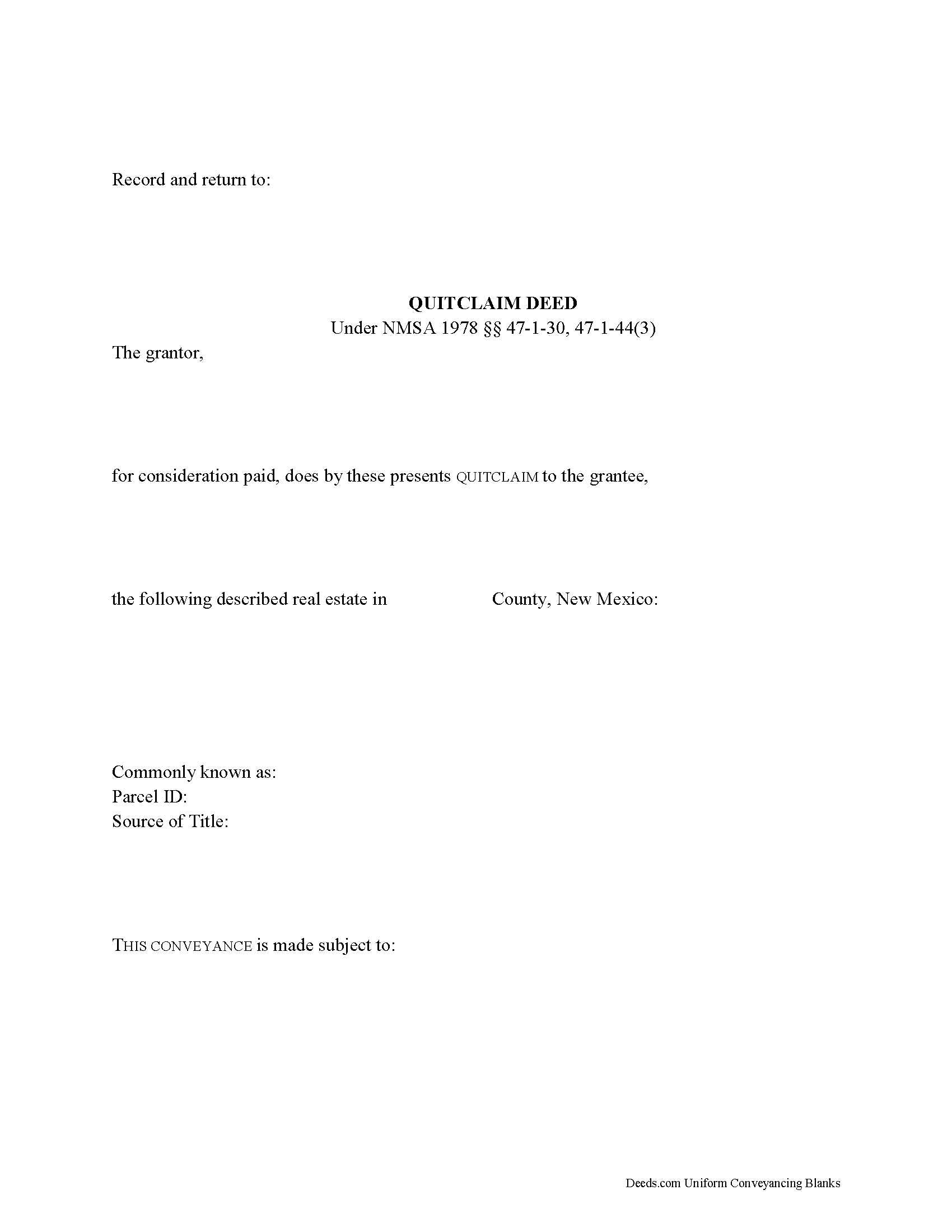
In New Mexico, real property can be transferred from one party to another by executing a quitclaim deed. Quitclaim deeds are statutory under NMSA 1978 Section 47-1-44(3).
Quitclaim deeds offer no warranties of title and provide the least amount of protection to the grantee. They do not guarantee that the grantor has good title or ownership of the property and only transfer whatever interest the grantor may have in the property at the time of execution. They are typically used in divorce proceedings or other transfers of property pursuant to court order, or to clear title.
A lawful quitclaim deed includes the grantor's full name, mailing address, and marital status, and the grantee's full name, mailing address, marital status, and vesting. Vesting describes how the grantee holds title to the property. Generally, real property is owned in either sole ownership or in co-ownership.
For New Mexico residential property, the primary methods for holding title in co-ownership are tenancy in common, joint tenancy, and community property. A grant of ownership of real estate to two or more unmarried persons is presumed to create a tenancy in common, unless a joint tenancy is expressl... More Information about the New Mexico Quitclaim Deed
Gift Deed
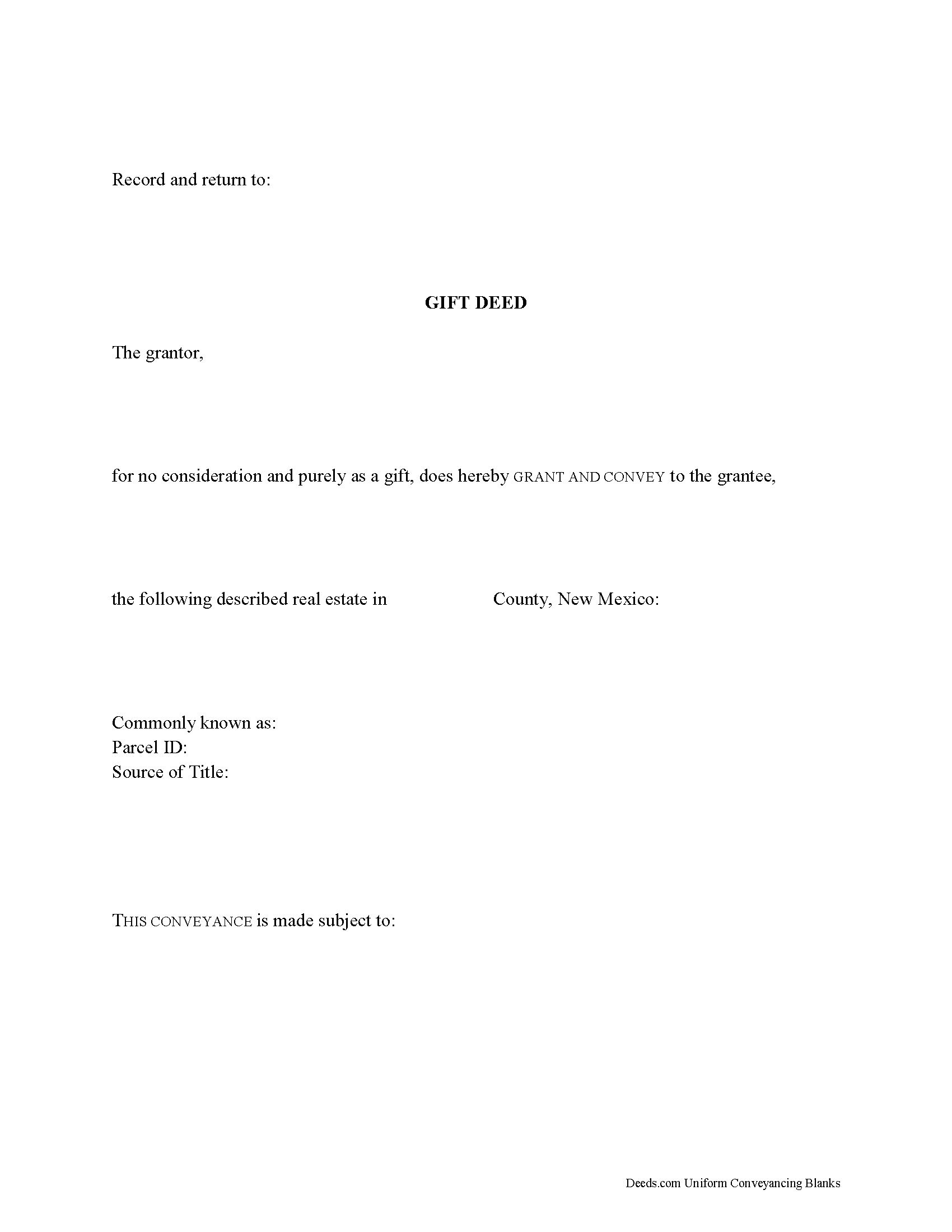
Gifts of Real Property in New Mexico
A gift deed, or deed of gift, is a legal document voluntarily transferring title to real property from one party (the grantor or donor) to another (the grantee or donee). A gift deed typically transfers real property between family or close friends. Gift deeds are also used to donate to a non-profit organization or charity. The deed serves as proof that the transfer is indeed a gift and without consideration (any conditions or form of compensation).
Valid deeds must meet the following requirements: The grantor must intend to make a present gift of the property, the grantor must deliver the property to the grantee, and the grantee must accept the gift. Gift deeds must contain language that explicitly states no consideration is expected or required, because any ambiguity or reference to consideration can make the deed contestable in court. A promise to transfer ownership in the future is not a gift, and any deed that does not immediately transfer the interest in the property, or meet any of the aforementioned requirements, can be revoked [1].
A lawful gift deed includes the grantor's full name and marital status, as well as the grantee'... More Information about the New Mexico Gift Deed
Warranty Deed
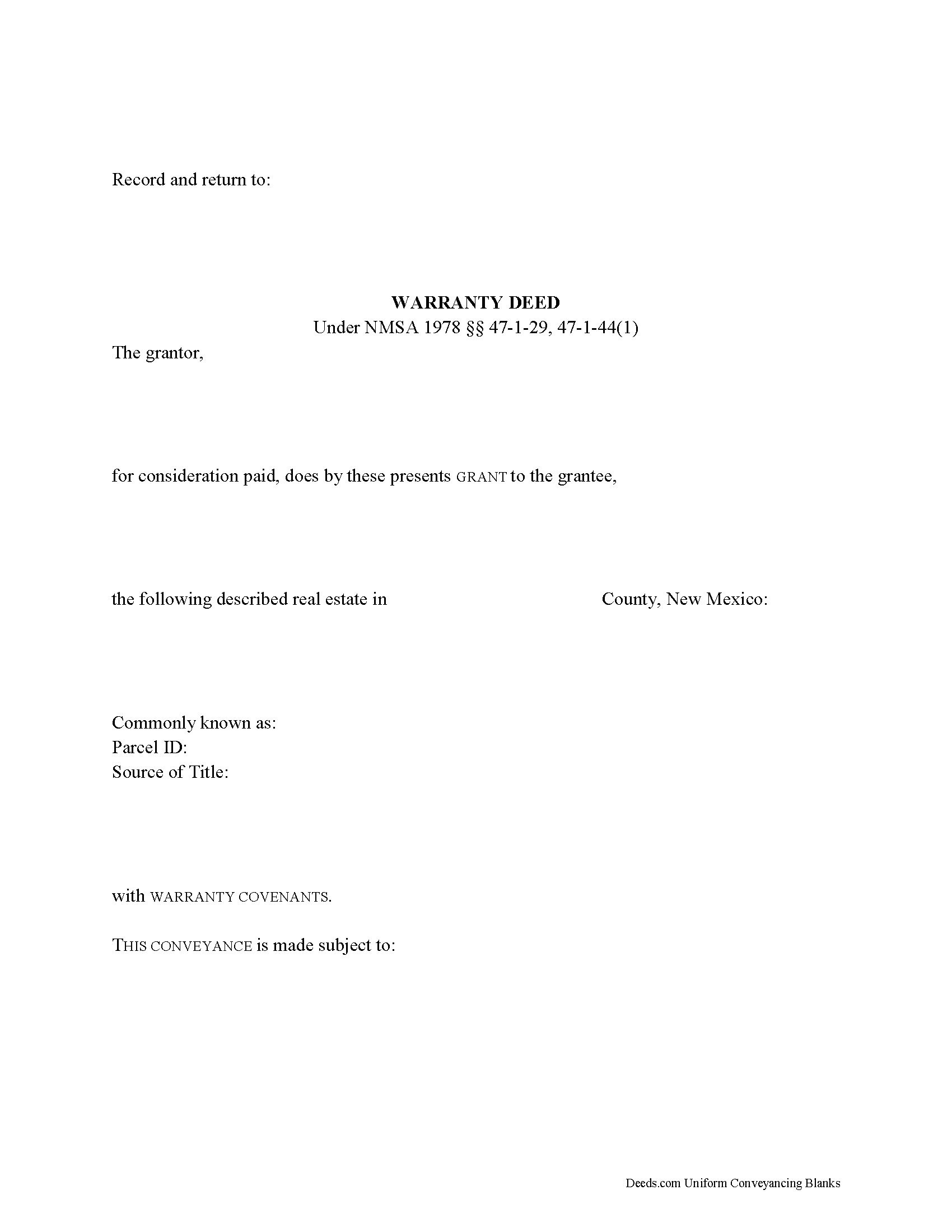
In New Mexico, real property can be transferred from one party to another by executing a warranty deed. Warranty deeds are statutory under NMSA 1978 Sections 47-1-29 and 47-1-44(1).
The statutory form includes the words "with warranty covenants" (NMSA 1978 Section 47-1-44(1)). When the words "warranty covenants" are used in a conveyance, they carry implied covenants that the grantor holds title to the property; that the property is free from encumbrances (with the exception of any noted in the deed); that the grantor has "good right to sell and convey the same"; and that the grantor, "and his heirs, executors, administrators, and successors shall warrant and defend" the title against all lawful claims and demands (NMSA 1978 Section 47-1-37). So, statutory warranty deeds offer the highest level of protection to the grantee.
A lawful warranty deed includes the grantor's full name, mailing address, and marital status, and the grantee's full name, mailing address, marital status, and vesting. Vesting describes how the grantee holds title to the property. Generally, real property is owned in either sole ownership or in co-ownership.
For New Mexico residential property, the pri... More Information about the New Mexico Warranty Deed
Special Warranty Deed
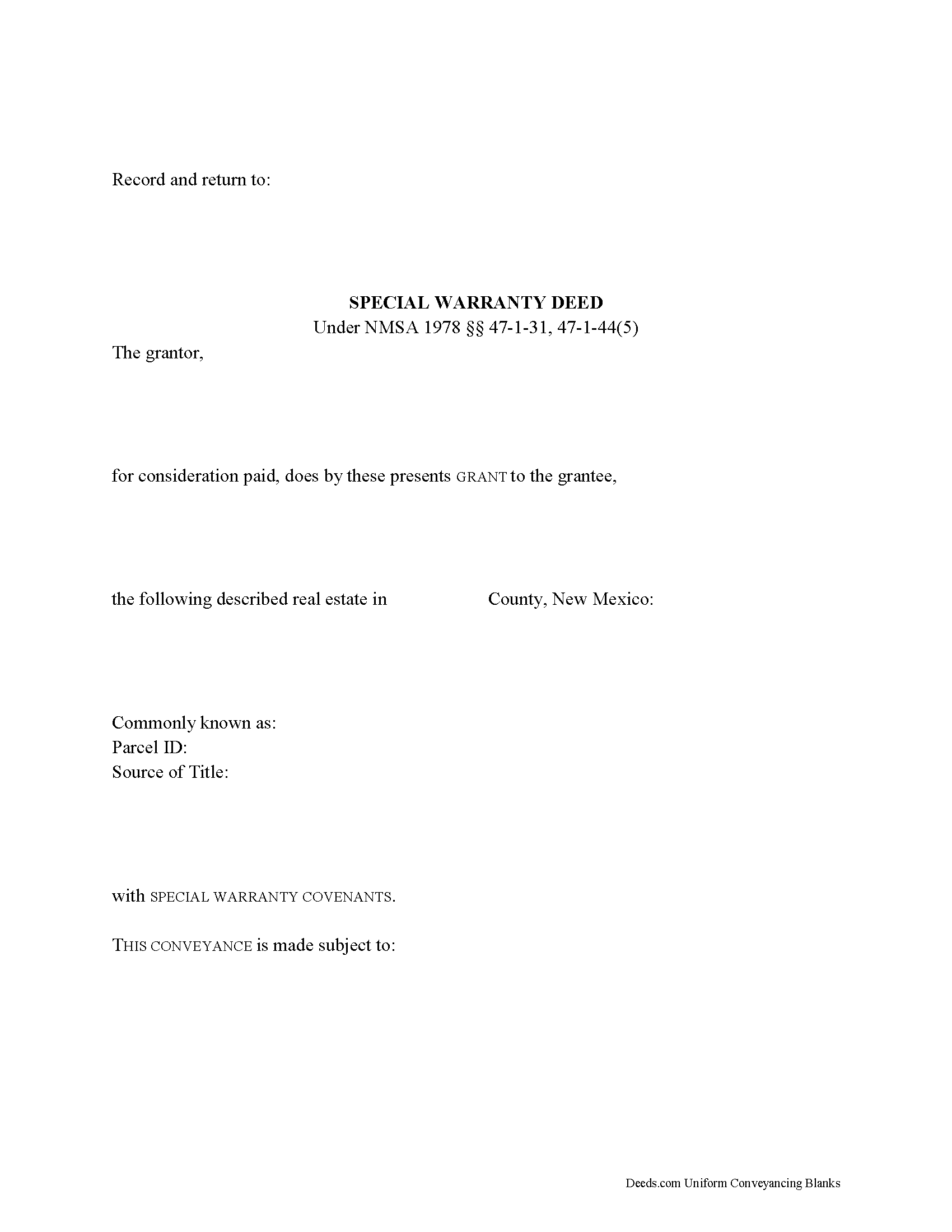
In New Mexico, real property can be transferred from one party to another by executing a special warranty deed. Special warranty deeds are statutory under NMSA 1978 Sections 47-1-31 and 47-1-44(5).
The statutory form includes the words "with special warranty covenants" (NMSA 1978 Section 47-1-44(5)). The words "special warranty covenants" carry implied covenants that the property is free from encumbrances made by the grantor (with the exception of any noted in the deed), and that the grantor, "and his heirs, executors, administrators, and successors shall warrant and defend" the title against lawful claims and demands of "all persons claiming by, through or under the grantor, but against none other" (NMSA 1978 Section 47-1-38). So, unlike a general warranty deed under 47-1-37, a special warranty deed only guarantees the title against claims that arose during the time the grantor held title to the property.
A lawful special warranty deed includes the grantor's full name, mailing address, and marital status, and the grantee's full name, mailing address, marital status, and vesting. Vesting describes how the grantee holds title to the property. Generally, real property is owned ... More Information about the New Mexico Special Warranty Deed
Grant Deed
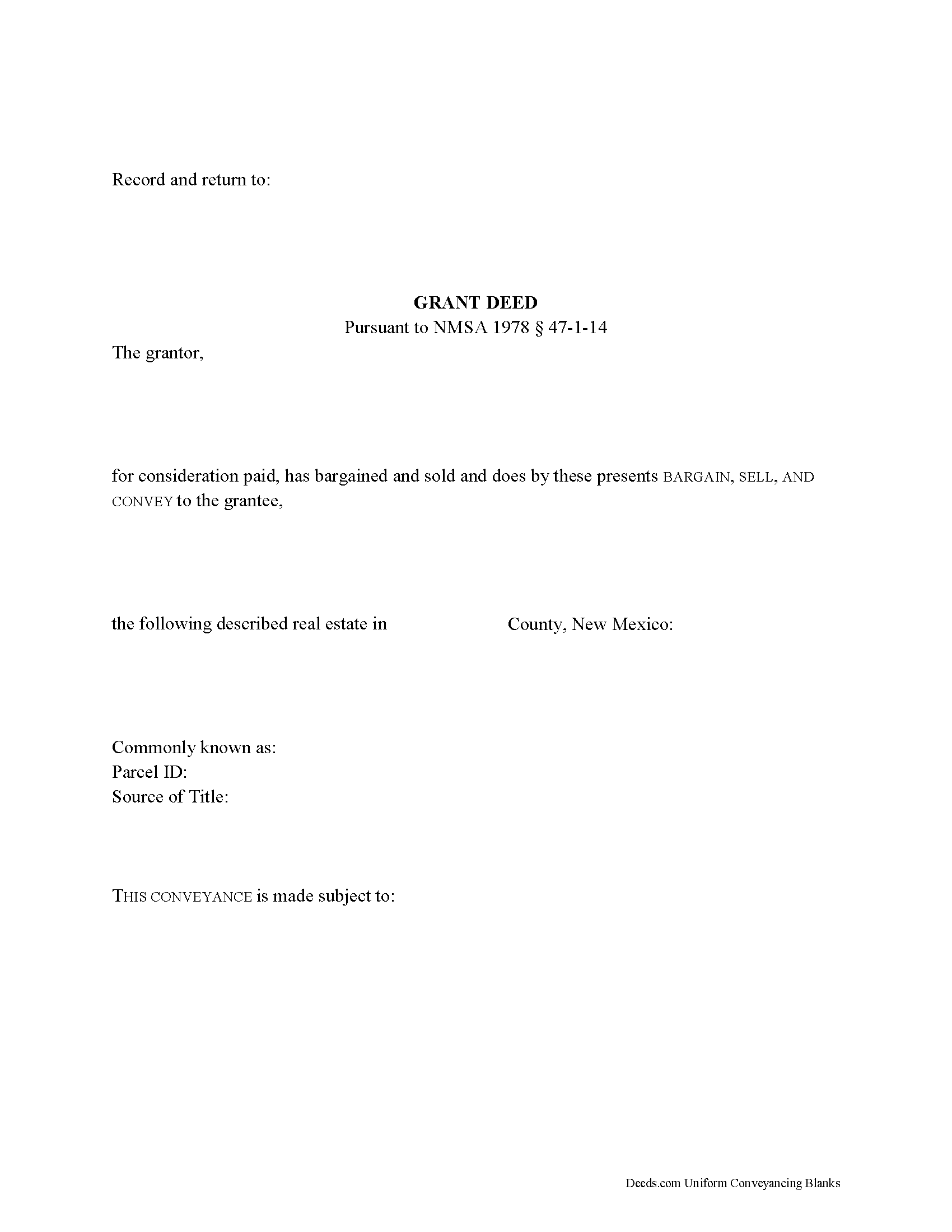
In New Mexico, real property can be transferred from one party to another by executing a grant deed. A standard grant deed conveys an interest in real property to the named grantee with covenants that the title is free of any encumbrances (except for those stated in the deed) and that the grantor holds an interest in the property and is free to convey it. Grant deeds are not statutory in New Mexico, so the covenants should be explicit in the form of the instrument of transfer.
Grant deeds offer the grantee more protection than quitclaim deeds, but less than warranty deeds. A quitclaim deed includes no warranty of title, and only conveys any interest that the grantor may have in the subject property. A warranty deed provides more protection to the grantee than a grant deed because it requires the grantor to defend against all claims against the title.
A lawful grant deed includes the grantor's full name, mailing address, and marital status; the consideration given for the transfer; and the grantee's full name, mailing address, marital status, and vesting choice. Vesting describes how the grantee holds title to the property. Generally, real property is owned in either sole owne... More Information about the New Mexico Grant Deed
Correction Deed
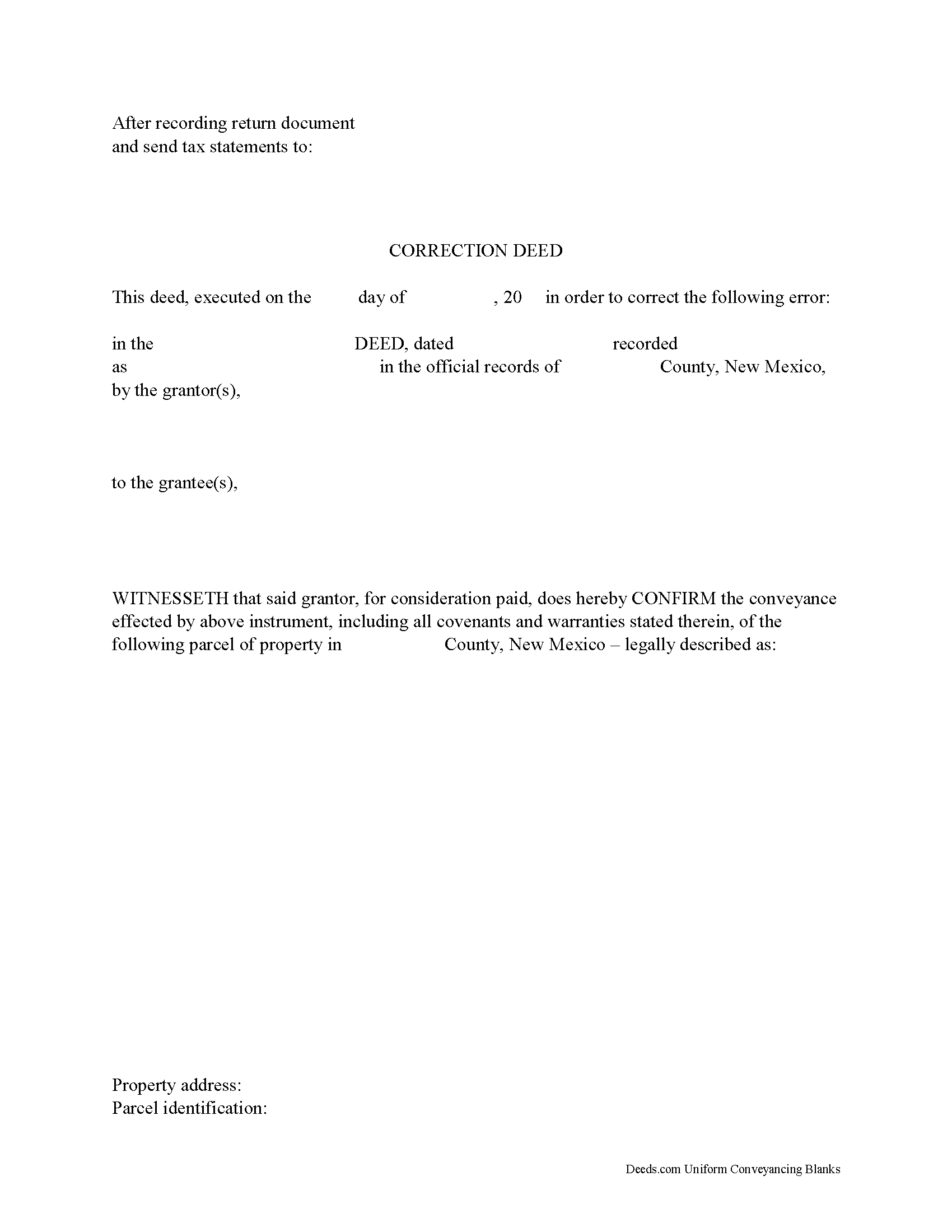
Use the correction deed to amend a previously recorded warranty, special warranty, or quitclaim deed.
A correction deed explains and corrects an error in a prior instrument, especially if such an error might cloud the title and potentially affect its future transfers. The correction deed passes no title, but reiterates and confirms the conveyance effected by the previously recorded document. Therefore, it must be executed from the original grantor to the original grantee and recorded in order to be legally valid.
The correction deed should reference the prior conveyance by type of error, date of execution, date of recording, as well as by recording number and location. Beyond that, it restates the information given in the prior deed, thus serving as its confirmation. The original instrument remains on record as well.
Deeds of correction are most appropriate for minor errors and omissions in the original deed, such as misspelled names, omission of marital status, or typos in the legal description. More substantial changes, such as adding a name to the title or adding/subtracting a portion of land to the legal description of the property, usually require a new deed of conve... More Information about the New Mexico Correction Deed
Easement Deed
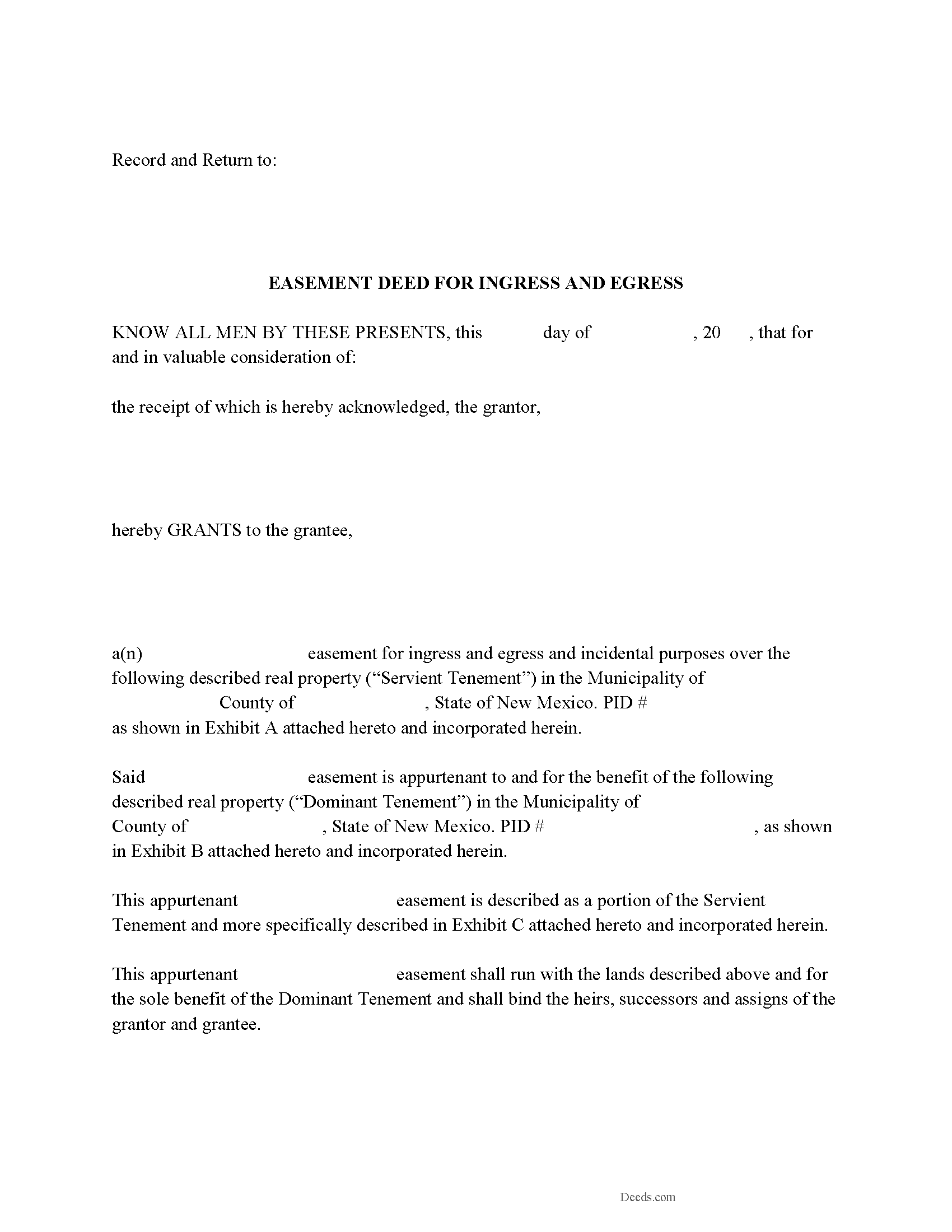
Easements are generally granted for a very specific purpose and can be either appurtenant or in gross. An easement gives one person the right to use another person's property for a specific purpose. In New Mexico, express easements are common, and are created by a deed, contract, or other written instrument. The easement deed should identify the location and dimensions of easement, the duration, the scope, and the parties who may use the easement. In a conveyance of real estate in this state, all easements, privileges, and appurtenances belonging to the granted estate are included in the conveyance, unless the deed states differently (47-1-34).
A land use easement in New Mexico is a holder's non-possessory interest in real property imposing any limitation or affirmative obligation for the purpose of retaining or protecting natural open space values of real property (47-12-2). A land use easement can be created, conveyed, recorded, assigned, released, modified, terminated, or otherwise altered or affected in the same manner as other easements created in this state. A solar right, defined in the New Mexico Annotated Statutes as a right to an unobstructed line-of-sight path from a ... More Information about the New Mexico Easement Deed
Termination of Easement
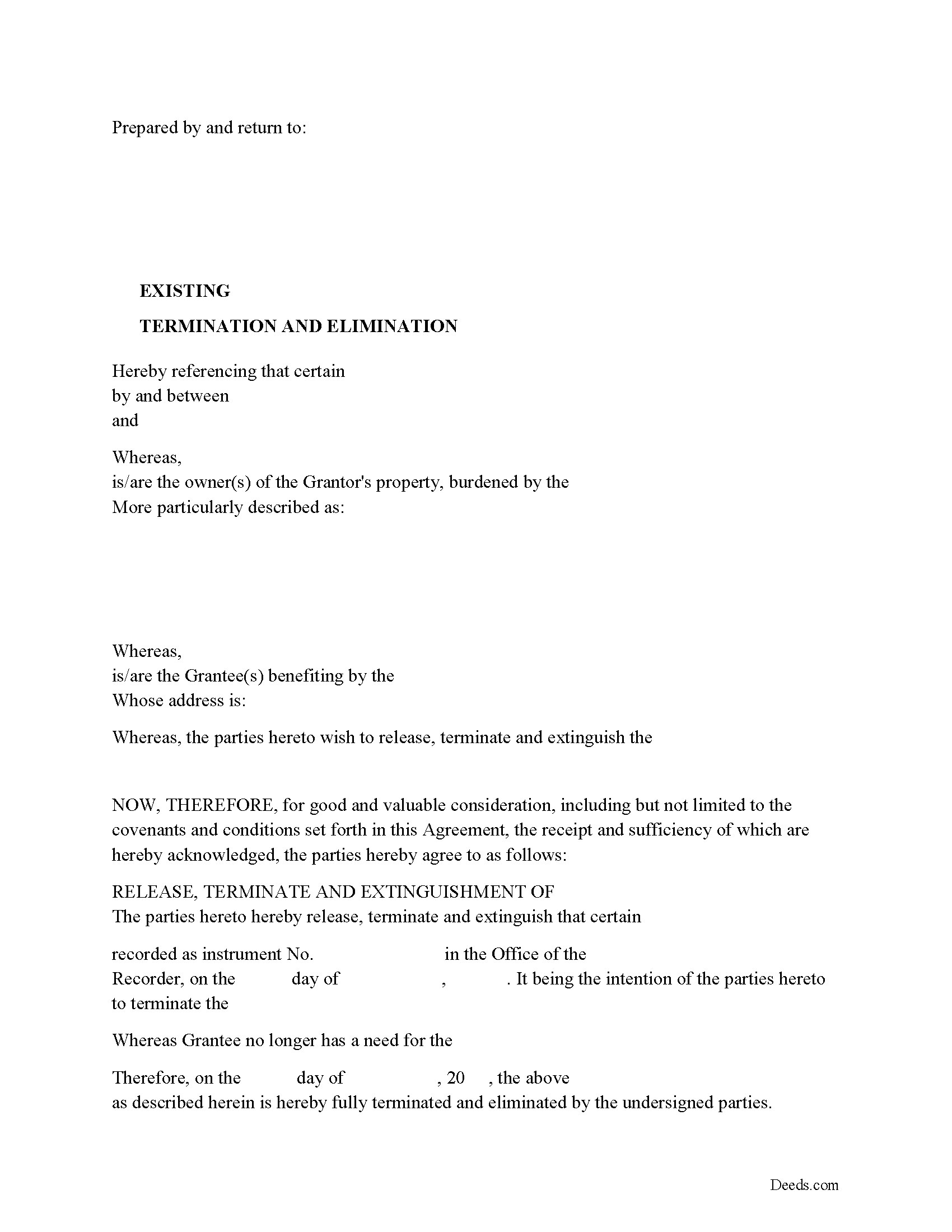
Use this form to release, terminate, extinguish a previously recorded document that involves access to and from a property.
Documents such as:
1. Easement Deeds or Agreements (An easement is a non-possessory interest in land, granting the right to use someone else's property for a specific purpose, like a driveway or utility line)
2. Access Roads
3. Right of Ways
4. Utility Easements (Power, Gas, Water, Sewer, Etc.)
5. Drainage Easements
This document allows the owner of the land, burdened by the access and the party that benefits from the access, to sign an agreement releasing the property from such access, ... More Information about the New Mexico Termination of Easement
Mortgage Secured by Promissory Note
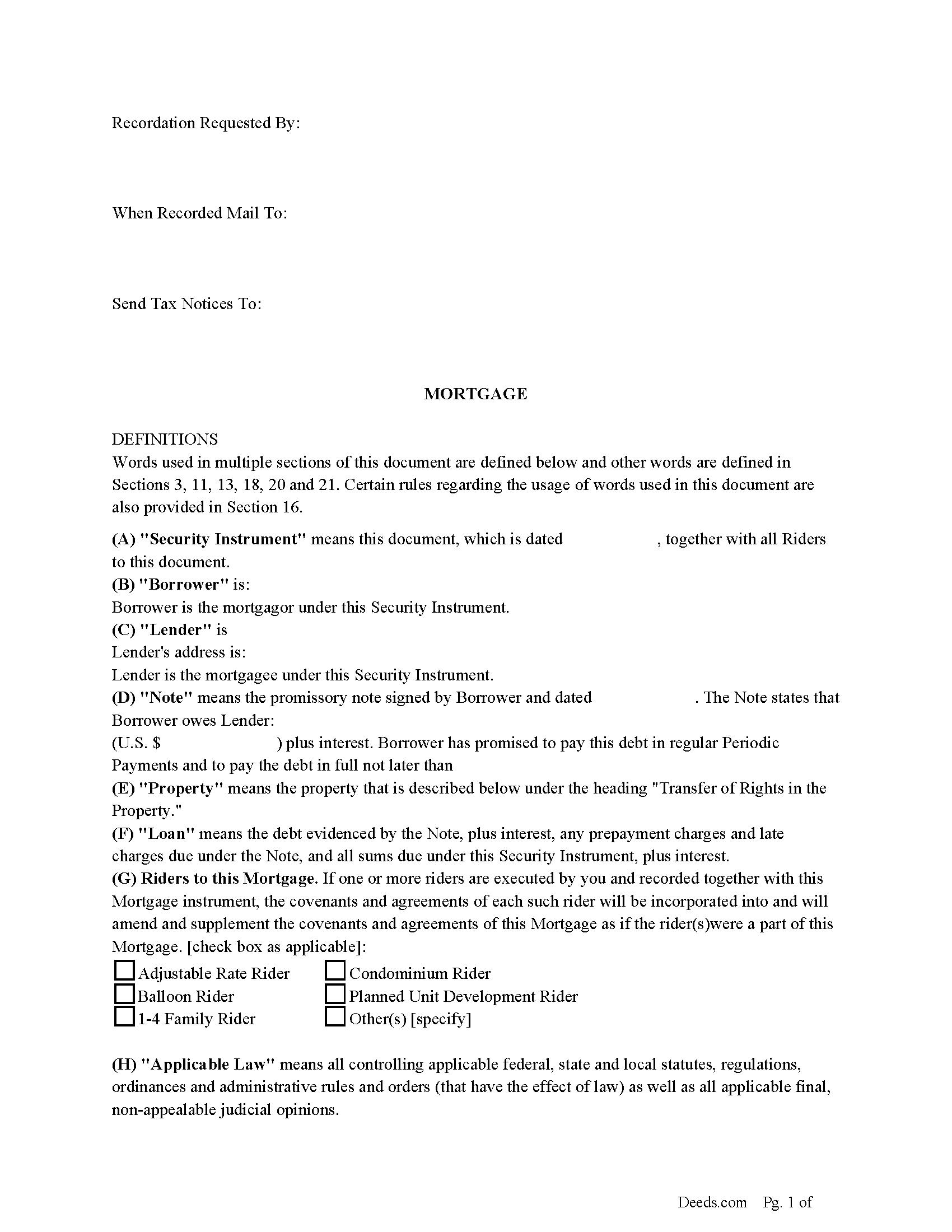
Use this form for financing residential property, small commercial, rental property (up to 4 units), condominiums and planned unit developments. This is a comprehensive 12-page form that has stringent default terms.
Use this form for financing residential property, small commercial, rental property (up to 4 units), condominiums and planned unit developments. This is a comprehensive 12-page form that has stringent default terms.
Promissory Note includes late charges. Any payment which is at least ____ days past due, shall be subject to a late charge of $___ And an additional $ ____per day until the payment is received. If any balloon payment is late, it shall be subject to a late fee of $____ per day.
Default Rate: I payment is/are at least 30 days past due, then the principal balance shall bear interest at default rate of (____%) over the interest rate stated. Said default rate shall begin on the ____ day following the due date of the payment(s) until payment(s) is/are brought
current. Payment(s) is/are first applied to accrued interest and penalties, then to principal.
In addition to any other remedies available to Lender if this Note is not paid in full at the Matu... More Information about the New Mexico Mortgage Secured by Promissory Note
Assignment of Mortgage
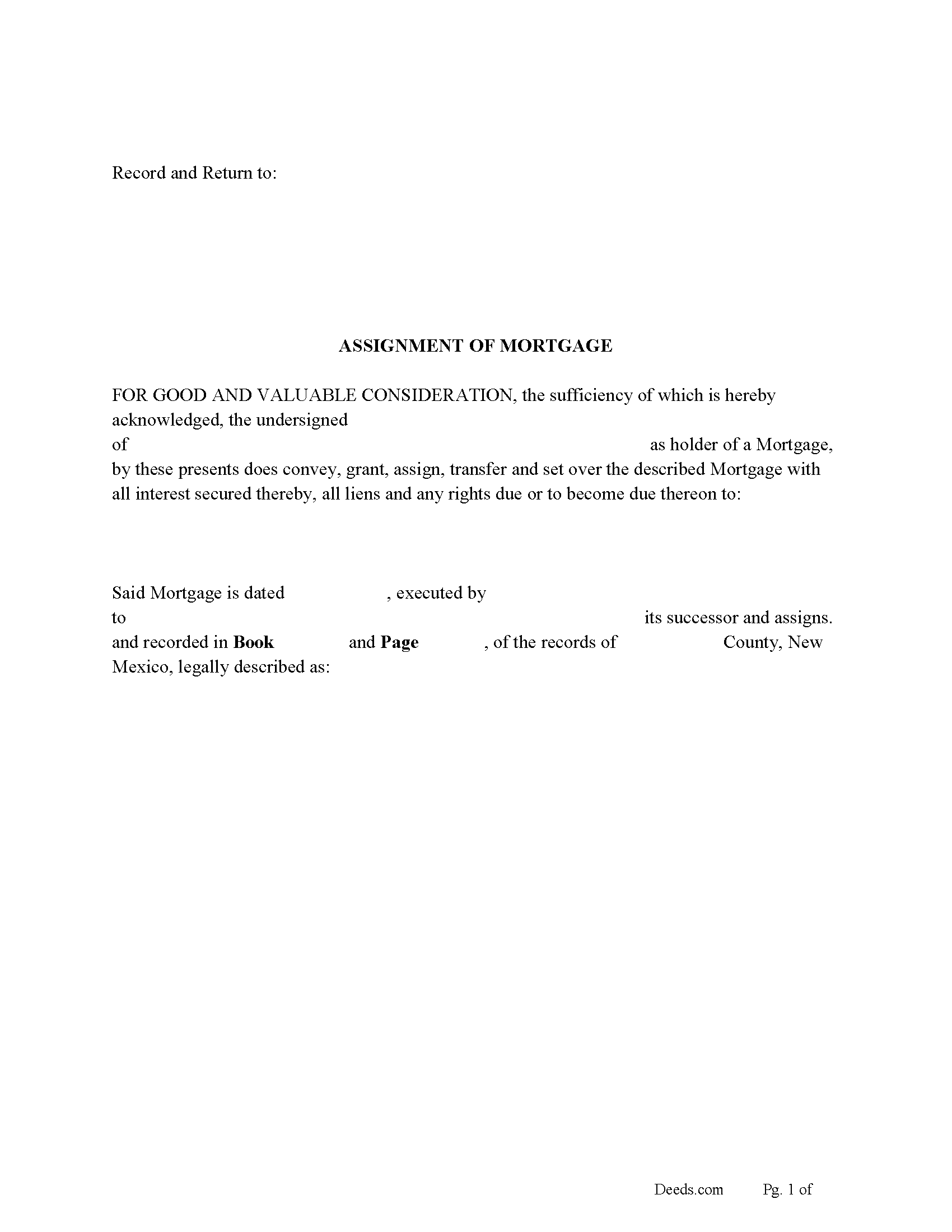
This Assignment of Mortgage form is commonly used when the current lender transfers the loan to a third party, this is typically done when the mortgage is sold to the third party.
48-7-2. [Assignments of mortgages; recording; person entitled to payment; effect of failure to record; assignee's action against assignor.]
In cases where assignments of real estate mortgages are made subsequent to the date this act takes effect, and such assignments are not recorded in the office of the county clerk of the proper county, the mortgagor, his heirs, personal representatives or assigns may pay the principal debt secured by such mortgage or accrued interest thereon, prior to the recording of such assignment, to the mortgagee; but if an assignment of such mortgage appears upon the proper record of such county clerk, then such payment may be made to the last assignee whose assignment is so recorded, and such payment shall be effectual to extinguish all claims against such mortgagor, his heirs, personal representatives or assigns, for or on account of such interest or such principal indebtedness. No transfer of any note, bond or other evidence of indebtedness, by endorsement or otherwise,... More Information about the New Mexico Assignment of Mortgage
Release of Mortgage
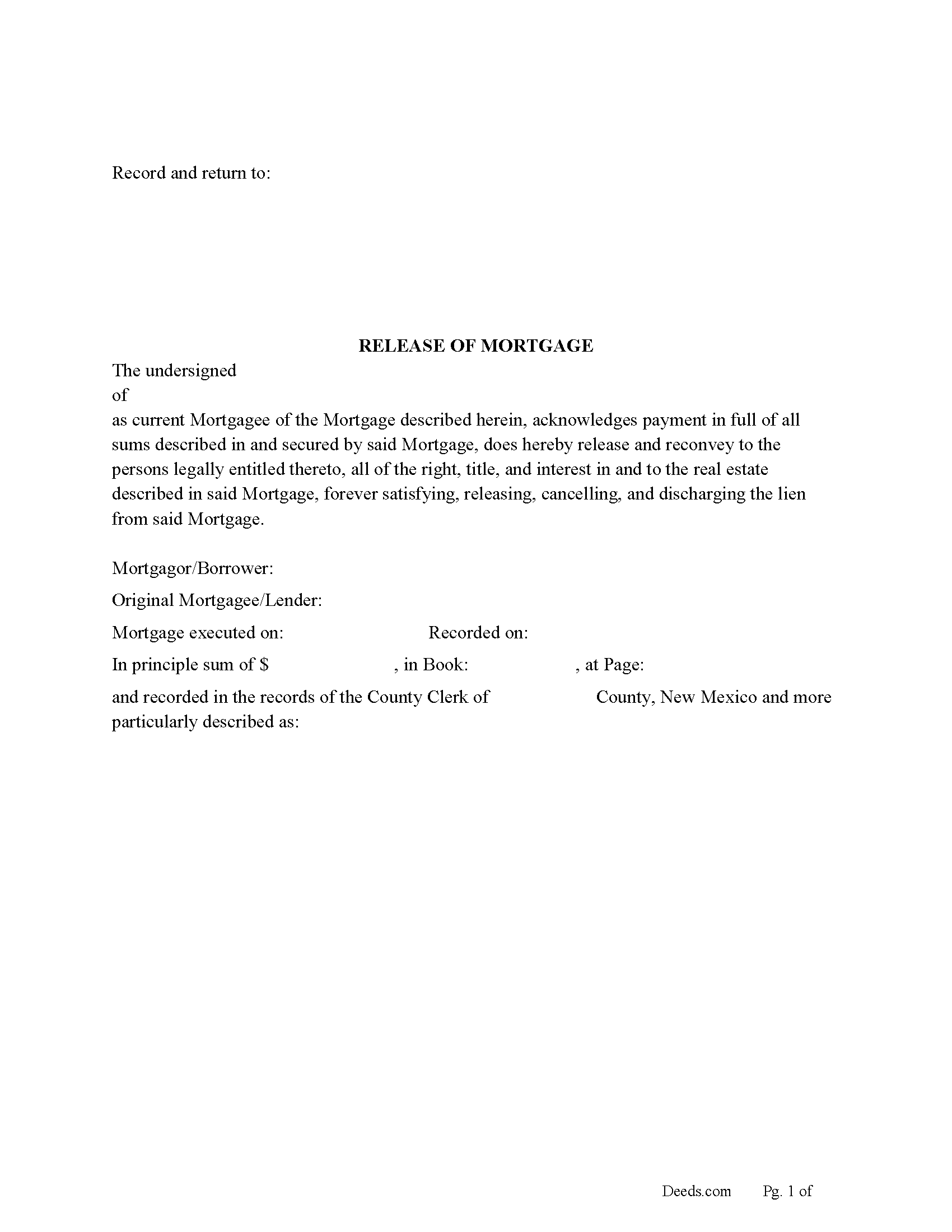
This form is used by the current lender/mortgagee. In general, a lender has 30 days to record a release once the note has been paid in full. (it is the duty of the mortgagee, trustee or the assignee of the debt or evidence of debt, as the case may be, to cause the full satisfaction of it to be entered of record in the office of the county clerk of the county where the mortgage or deed of trust is recorded.)(NM 48-7-4 (A))
(New Mexico ROM Package includes form, guidelines, and completed example) For use in New Mexico only.
... More Information about the New Mexico Release of Mortgage
Deed of Trust and Promissory Note
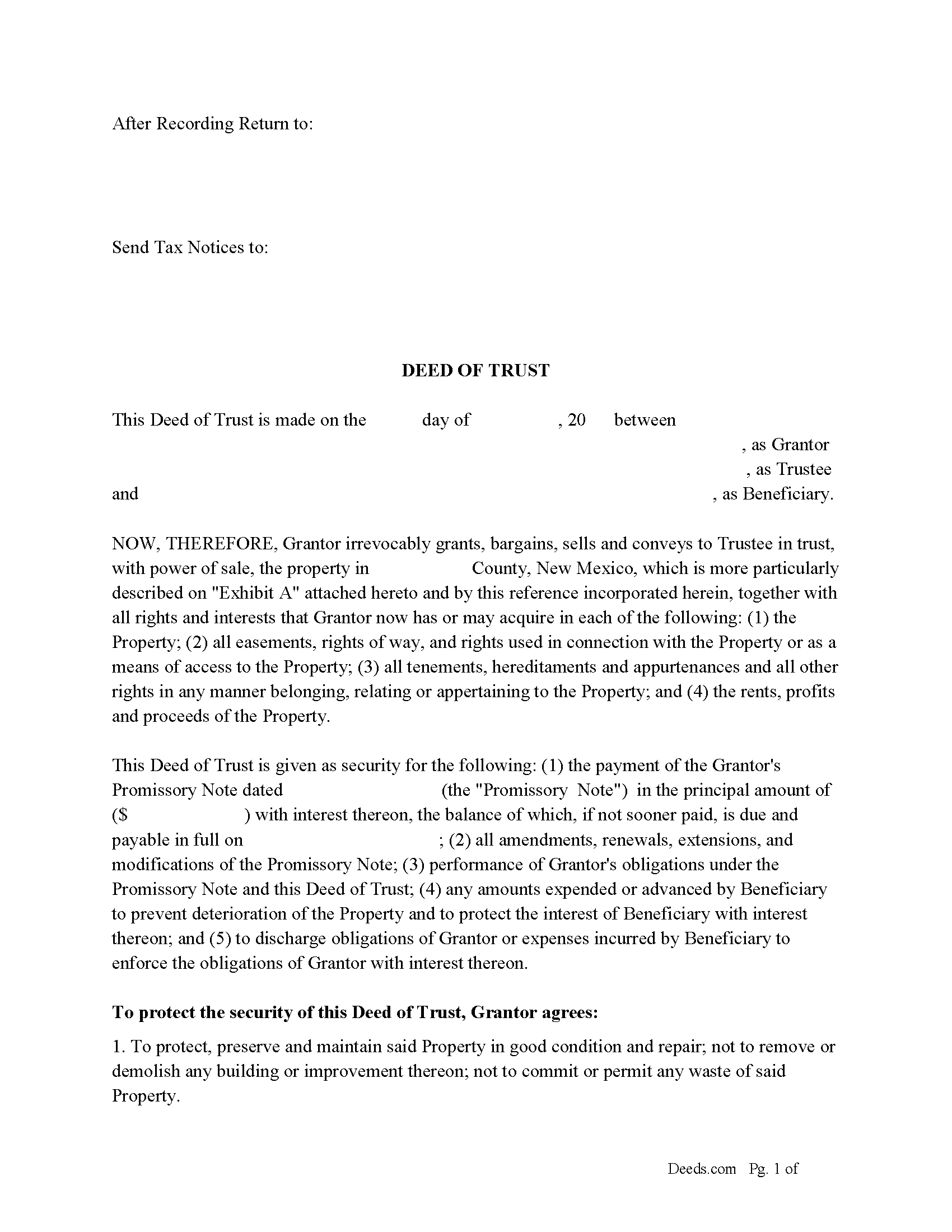
New Mexico has the Deed of Trust Act.
Foreclosure can be done non-judicially, saving time and expense. This process is called a Trustee Sale. After the Trustee sale the borrower has a right to redeem the property. This form allows one-month vs nine-months.
NM Statute 48-10-16(A)
Except as otherwise provided in Subsection E of this section, the redemption period after a trustee's sale shall be nine months, or the period provided in the deed of trust, whichever is the lesser period, and shall begin to run from the date of the trustee's sale. In the deed of trust, the parties may shorten the redemption period to not less than one month.
There are three parties in this Deed of Trust:
1- The Grantor (Borrower)
2- Beneficiary (Lender) and a
3- Trustee (Neutral Third Party)
Basic Concept. The Grantor (Borrower) conveys property title to a Trustee (Neutral Party). A Trustee or beneficiary can take an action against any person for damages.
Use this form for financing residential property, small commercial, rental property (up to 4 units), condominiums and planned unit developments. A Deed of Trust and Promissory Note with stringent default terms/conditions can be beneficial t... More Information about the New Mexico Deed of Trust and Promissory Note
Assignment of Deed of Trust
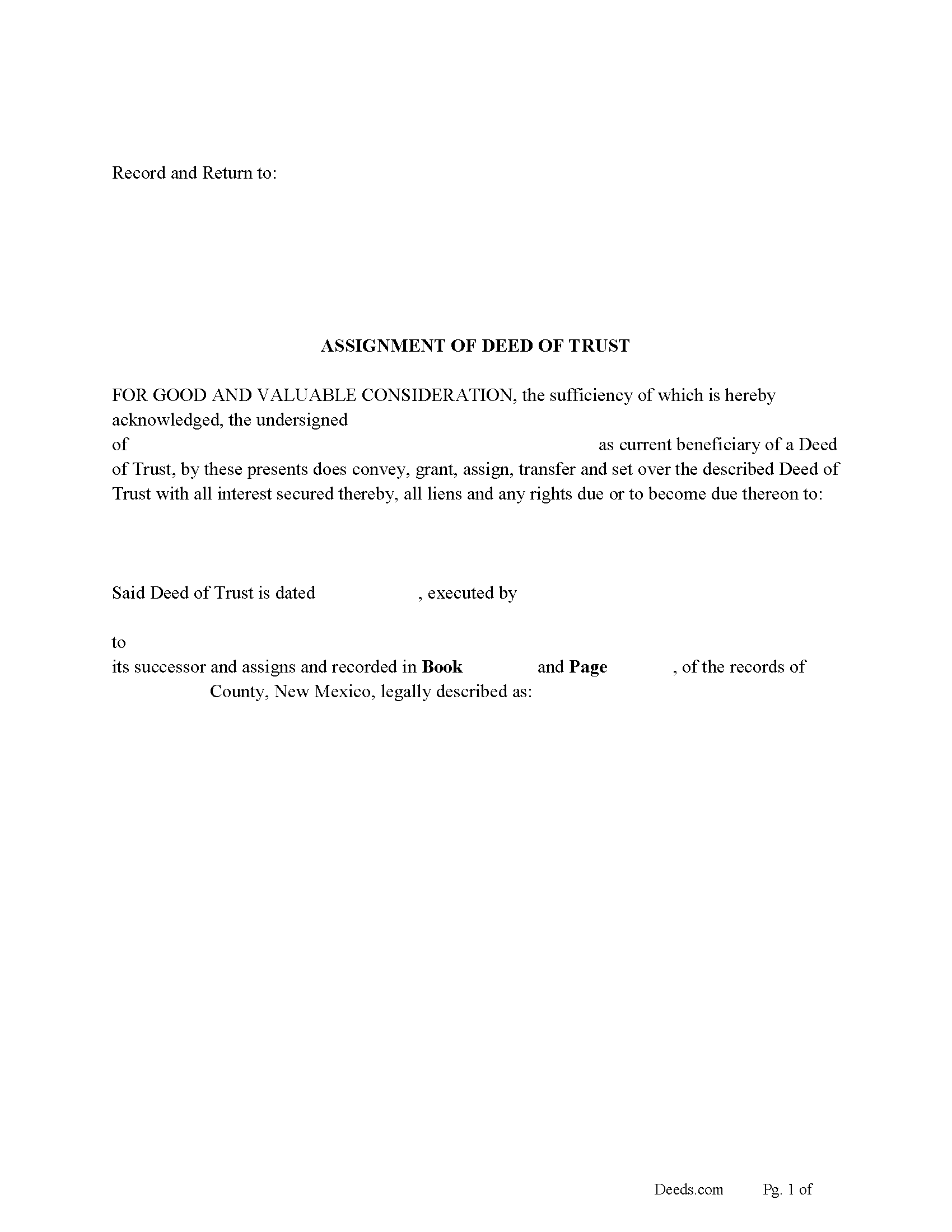
A Deed of Trust assignment, also referred to as an "Assignment of Deed of Trust", occurs when the beneficiary/lender of the loan transfers their loan obligations to a third party. The lender will usually assign a Deed of Trust by selling it to a new bank or lender. This form can be used by the current beneficiary/lender even if the Deed of Trust in question states a different beneficiary/lender.
Current Borrowers must be notified of the assignment. Notification consists of contact information of the new creditor, recording dates, recording instrument numbers, changes in loan, etc. Included are "Notice of Assignment of Deed of Trust" forms.
The Truth and lending act requires that borrowers be notified when their Deed of Trust debt has been sold, transferred, or assigned to a new creditor. Generally, within 30 days to avoid up to $2,000.00 in statutory damages, plus reasonable attorney's fees. Systematic violations can reach up $500,000.00.
(New Mexico Assignment of DOT Package includes form, guidelines, and completed example) For use in New Mexico Only.
... More Information about the New Mexico Assignment of Deed of Trust
Release of Deed of Trust
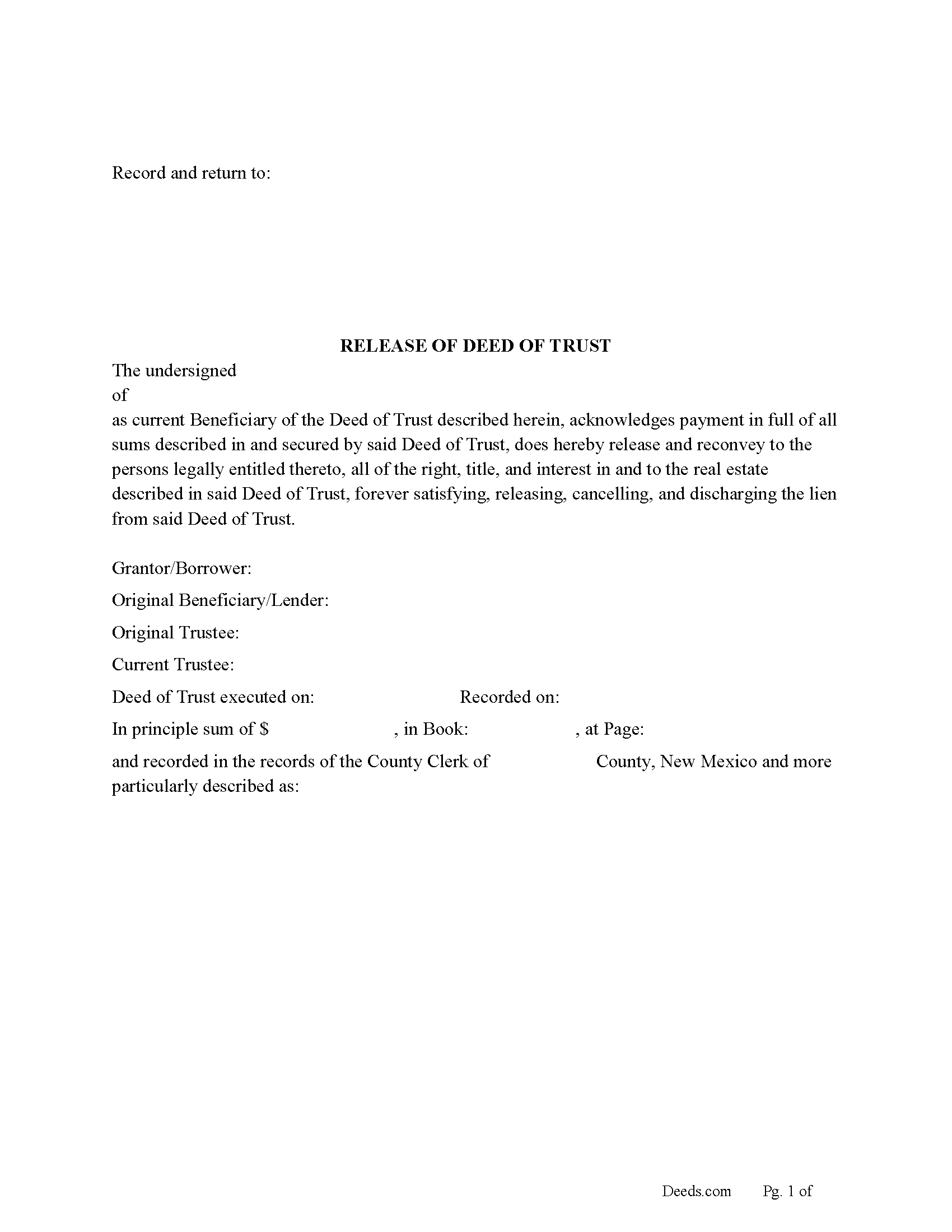
In New Mexico, the Trustee or the Beneficiary/Lender can release a Deed of Trust. This form is used by the Beneficiary/Lender. NM Stat 48-7-4(C)(2018) If, at any time the obligation secured by the mortgage or deed of trust described in Subsection B of this section is fulfilled, and the balance is zero, the mortgagee or beneficiary shall cause the mortgage or deed of trust to be released of record upon written demand of the mortgagor, trustor or the successor or assignee thereof.
48-7-5. Failure to release; penalty; civil liability.]
Any person who shall be guilty of violating the preceding section [48-7-4 NMSA 1978], upon conviction before any justice of the peace [magistrate] or district court having jurisdiction of the same shall be punished by a fine of not less than ten [($10.00)] nor more than twenty-five dollars [($25.00)], and shall be liable in a civil action to the owner of such real estate for all costs of clearing the title to said property including a reasonable attorney's fee.
(New Mexico Release of DOT Package includes form, guidelines, and completed example) For use in New Mexico only.
... More Information about the New Mexico Release of Deed of Trust
Personal Representative Deed
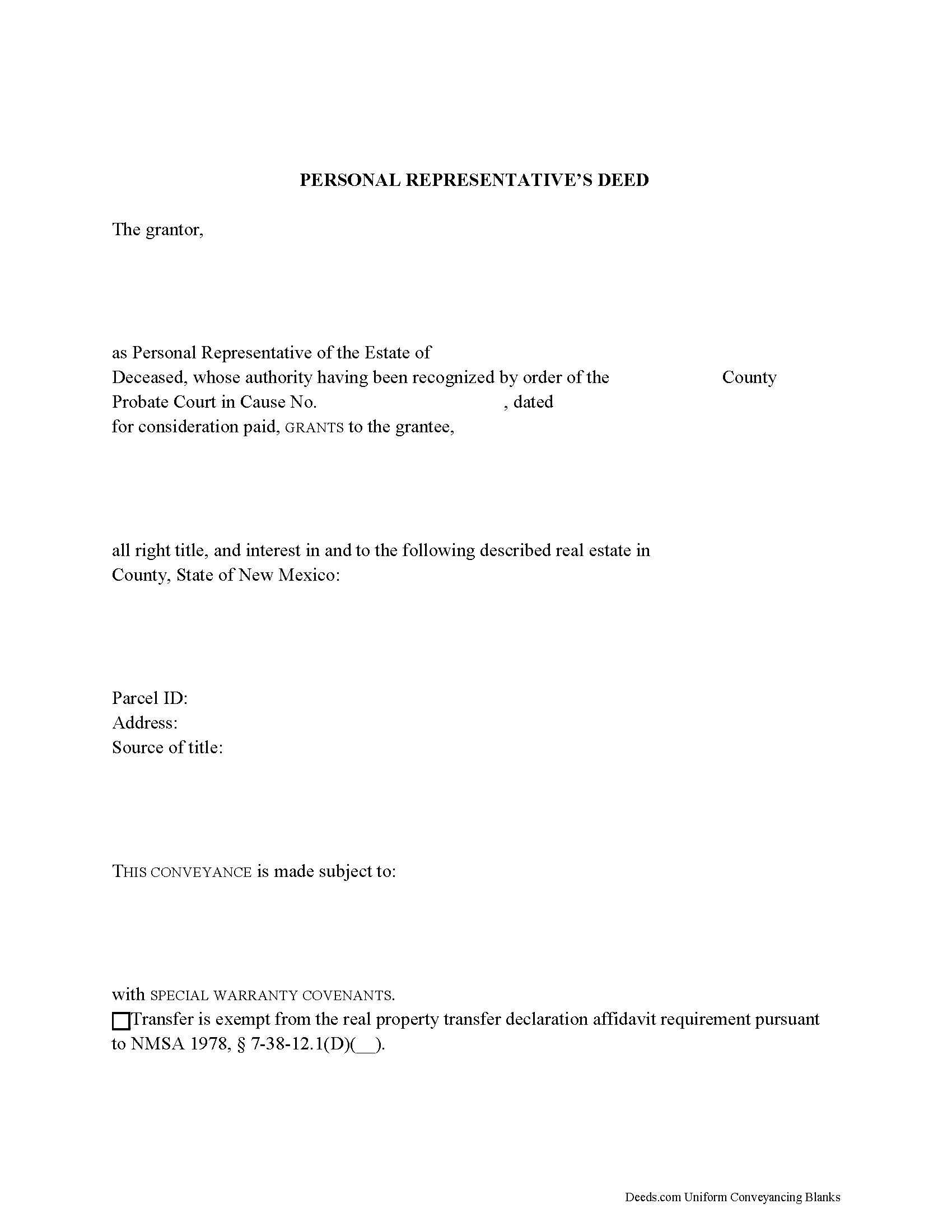
Transferring a Decedent's Realty in New Mexico
Probate is the court-supervised process of settling a decedent's (deceased person's) estate and distributing his or her assets according to the provisions of a will or pursuant to laws of intestate succession.
New Mexico is one of 18 states as of the time of this writing to adopt the Uniform Probate Code, a nationally-recommended set of laws governing the probate process. The Uniform Probate Code is codified at Chapter 45 of the New Mexico Statutes.
Probate of an estate takes place in the probate court of the New Mexico county wherein the decedent resided at the time of death. Contested cases may be brought before the district court.
When a decedent leaves property titled in his or her name individually, such property is subject to probate. Any realty the decedent held as a tenant in common must also pass through probate. If the decedent's estate includes realty not situated in the county where the estate is administered, NMSA 1978, 45-1-404 provides that a notice of administration be filed in the county wherein any ancillary real property is situated.
The Uniform Probate Code also addresses non-probate transfers of pro... More Information about the New Mexico Personal Representative Deed
Transfer on Death Deed
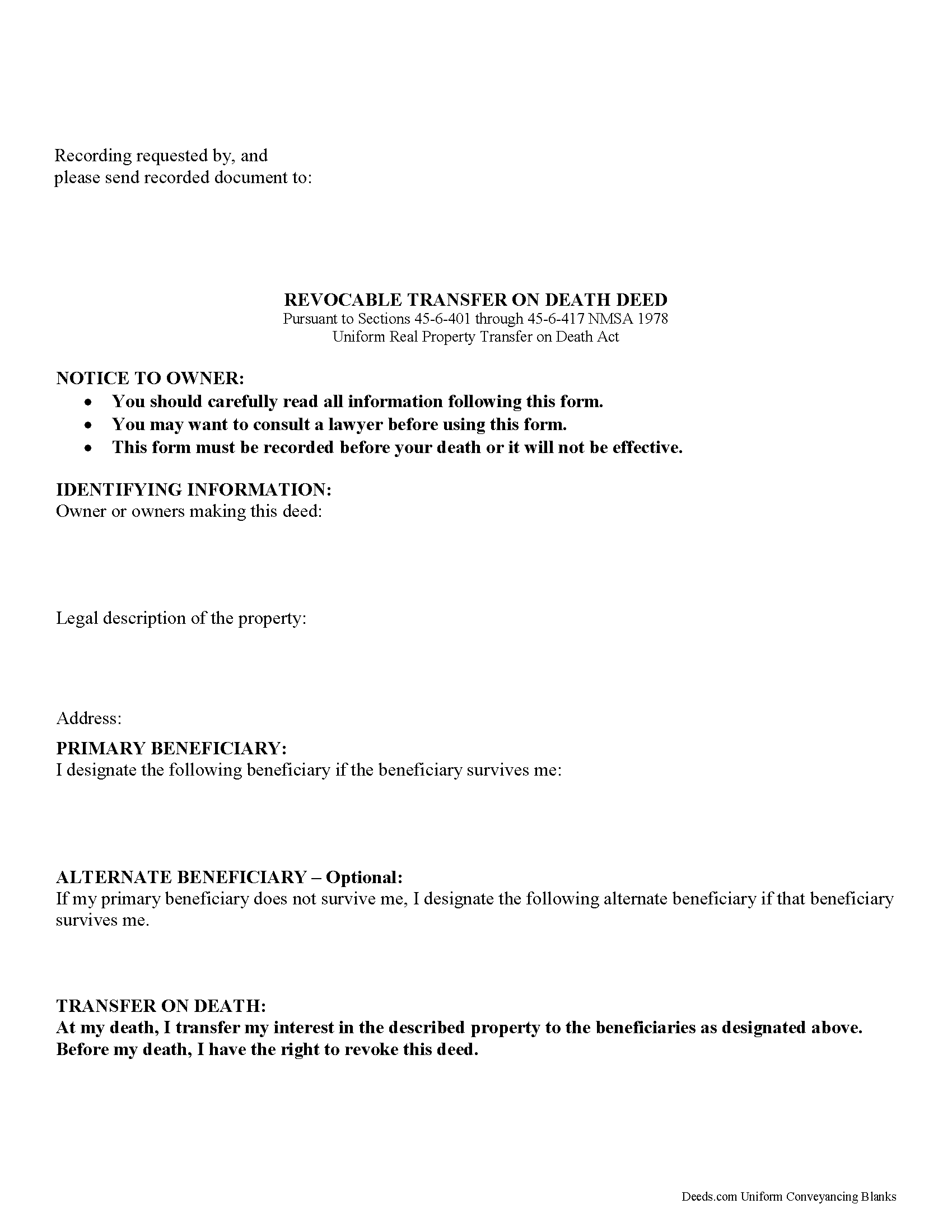
On January 1, 2014, New Mexico joined with eleven other states to enact the Uniform Real Property Transfer on Death Act (URPTODA), found at Sections 45-6-401 through 45-6-417 NMSA 1978 (2014). This enhances and adds clarity to the previous transfer on death statute already in force in the state.
A transfer on death deed (TODD) under the new law is defined by the Uniform Law Commission as an instrument that provides owners of real estate in New Mexico with a simple process for the non-probate transfer of real estate. The act allows an owner of real property to designate a beneficiary who will automatically receive the property upon the owner's death, without the need to include it in the decedent's probate estate. Instead, the property passes by means of a recorded TODD. During the owner's lifetime, the beneficiary of a TOD deed has no interest in the property and the owner retains full power to transfer or encumber the property, or even to revoke the deed outright.
New Mexico's version of the URPTODA sets out the rules and provides forms for both the deed and its revocation. To be valid, the TODD must meet three requirements ( 45-6-409):
1) it must contain the essential ... More Information about the New Mexico Transfer on Death Deed
Transfer on Death Revocation
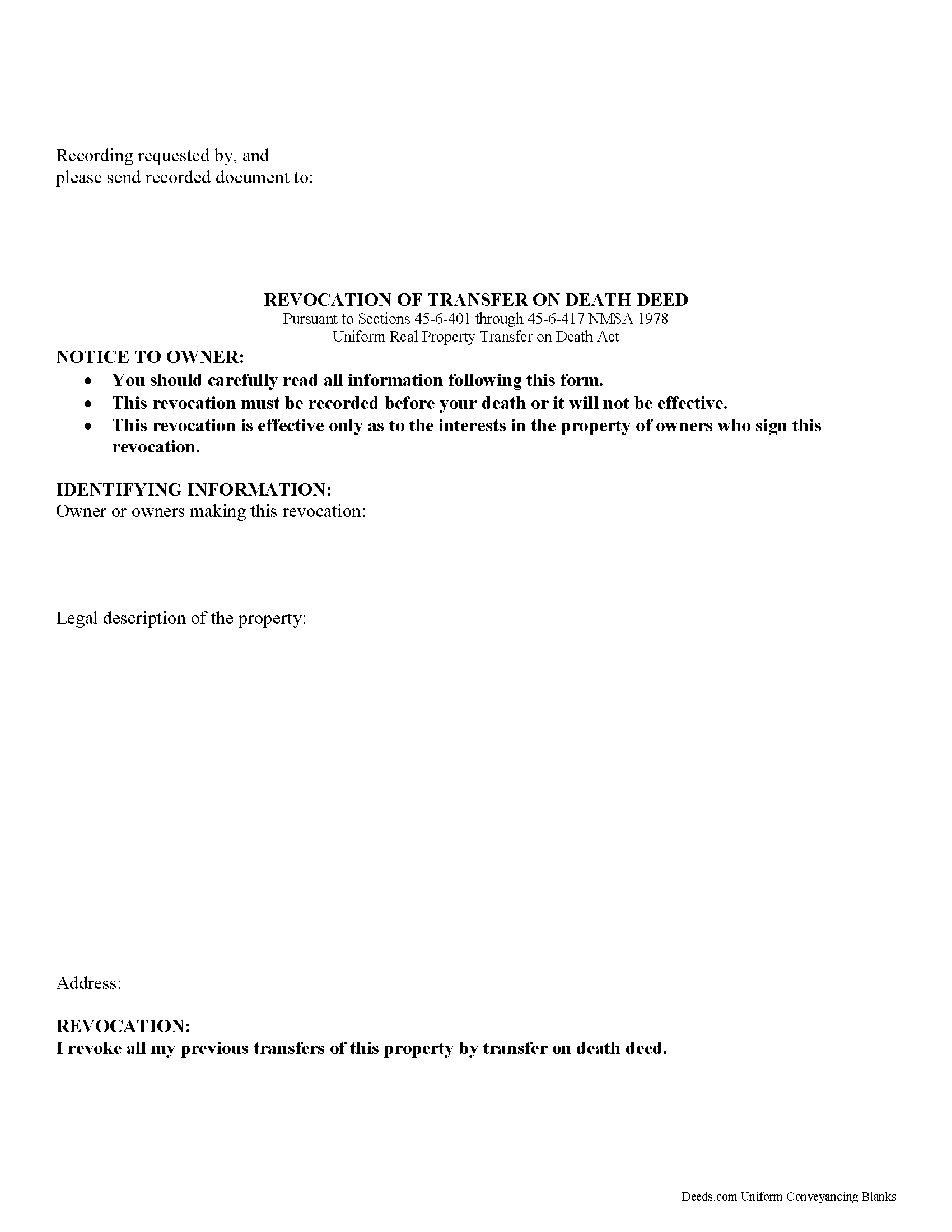
On January 1, 2014, New Mexico joined with eleven other states to enact the Uniform Real Property Transfer on Death Act (URPTODA), found at Sections 45-6-401 through 45-6-417 NMSA 1978 (2014). This updated law enhances and adds clarity to the previous transfer on death statute already in force in the state.
Real estate owners who record a transfer on death deed (TODD) under the URPTODA retain the ability to revoke the recorded conveyance. These deeds offer a potential future interest but no guarantee of anything; the beneficiary only gains title to the property rights present when the owner dies.
Why does revocability matter? Life is unpredictable. For example, the original beneficiary may become unable or unwilling to accept the property. Marriage or divorce could alter the nature of the relationship between the owner and the intended recipient. The owner/transferor might decide to use the land another way. Regardless of the reason, the ability to cancel or modify a recorded TODD without involving the courts or restructuring their entire estate plan lets owners resolve unexpected issues in a relatively simple way.
There are three primary methods for revoking a transfer... More Information about the New Mexico Transfer on Death Revocation
Affidavit of Facts as to Death
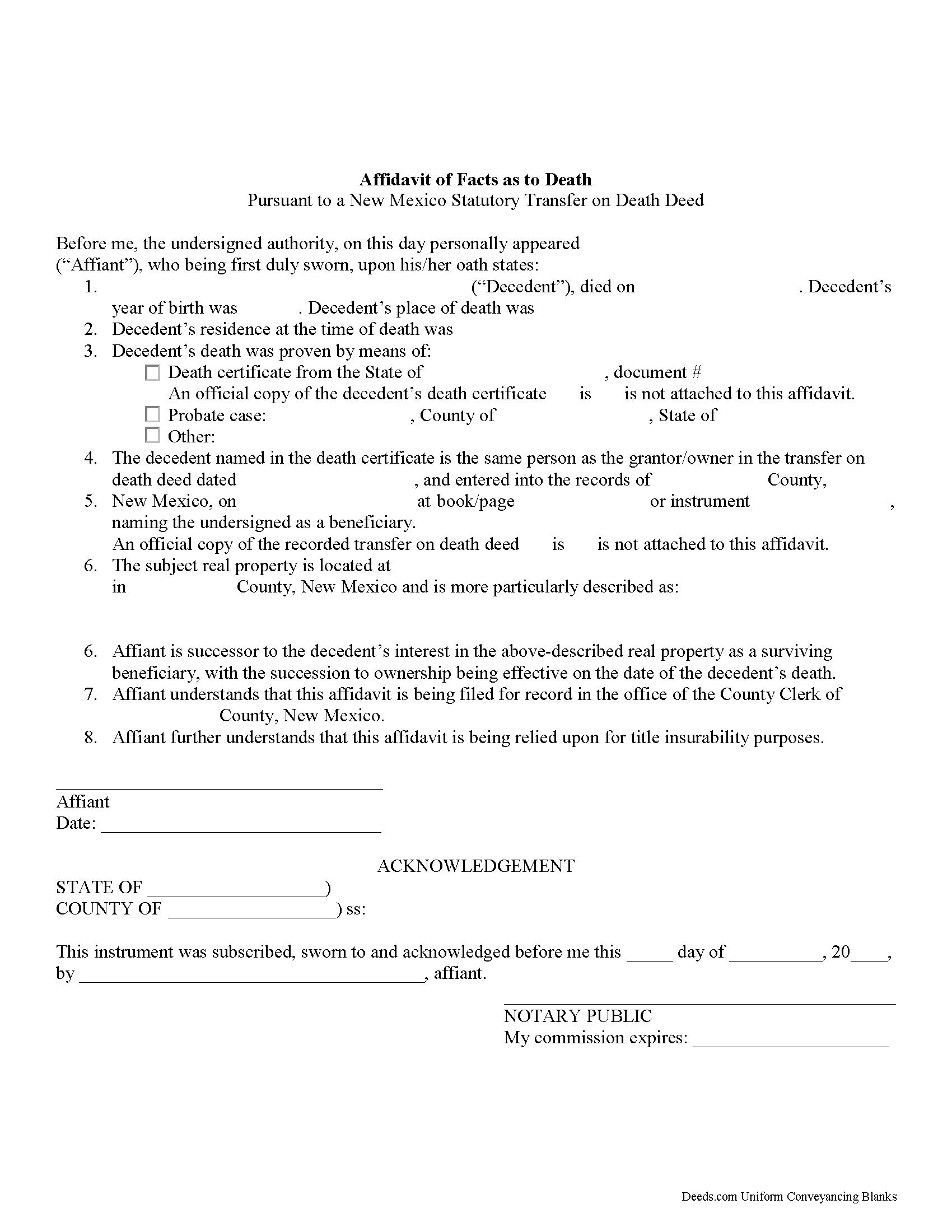
Completing the Transfer under a New Mexico Transfer on Death Deed
In January 2014, New Mexico updated its statutes relating to transfer on death deeds (TODD). This new information is codified at Sections 45-6-401 through 45-6-417 NMSA 1978.
The law for transferors is specific about executing and revoking TODDs, but offers almost no guidance to beneficiaries who wish to accept the real estate after the owner's death. Technically, the transferor's death triggers a change in ownership to the beneficiary, but how does that happen?
One way to formalize the title transfer is to file an <b>affidavit of facts as to death</b>. This document usually contains details about the recorded transfer on death deed as well as identification of the subject property. By submitting the affidavit to the recording office for the county where the land is situated, the beneficiary has protected his/her interest in the real estate and maintained a clear chain of title.
In addition to the affidavit itself, the beneficiary might submit an official copy of both the deceased transferor's death certificate and the recorded transfer on death deed, naming the beneficiary as the intended recipient of ... More Information about the New Mexico Affidavit of Facts as to Death
Notice of Administration
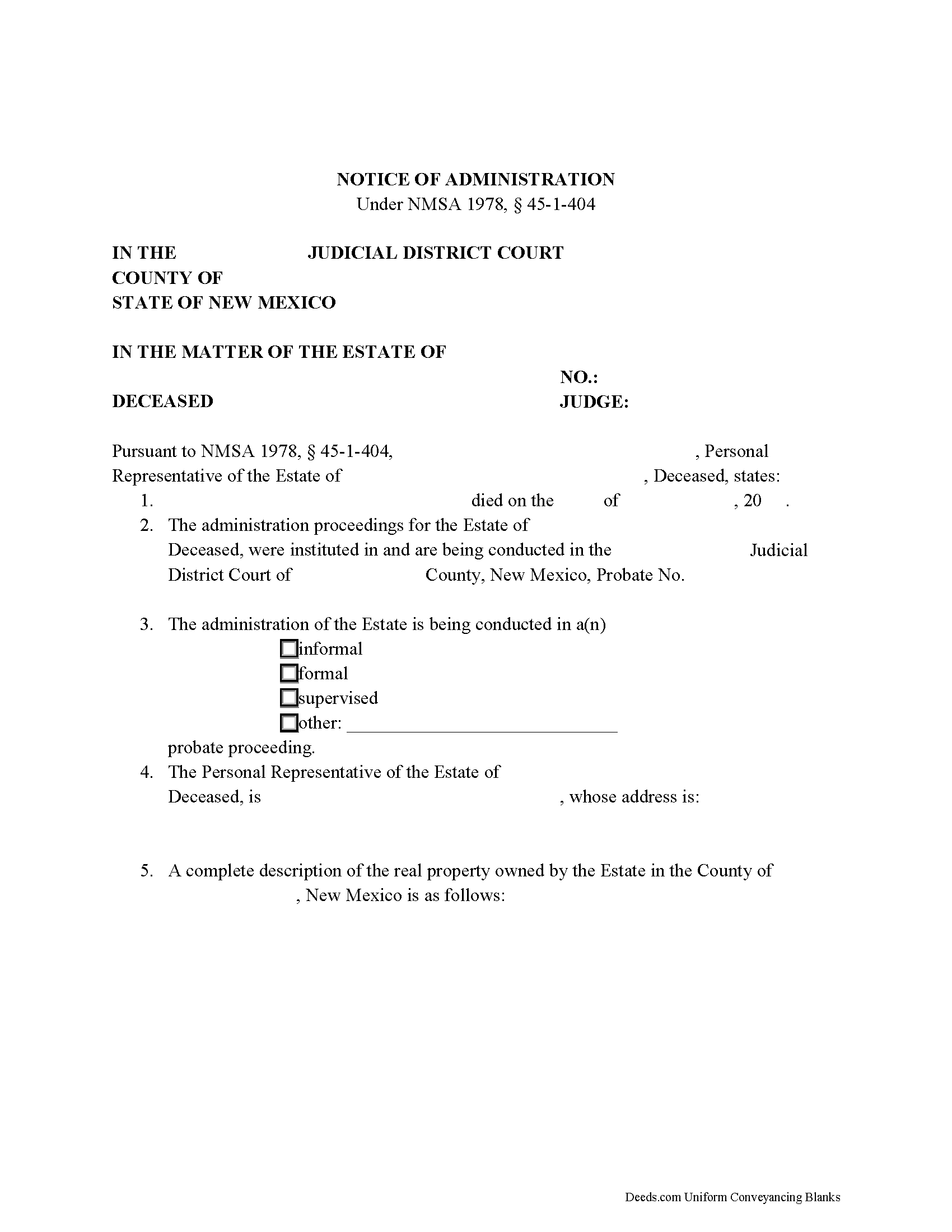
Probate, or the court supervised process of settling and distributing a decedent's estate, is commenced in the county where the decedent maintained a primary residence at the time of his or her death. What happens, though, when a decedent owned real property in New Mexico outside their county of residence?
For those situations, the estate's personal representative, (the fiduciary appointed by the court to administer the estate), is required to execute and file a statutory Notice of Administration under NMSA 1978, 45-1-404 in the county clerk's office where the property is situated.
The notice states the name of the decedent, the title and docket number of the administration proceedings, a description of the type of administration, the court where the administration is commenced, the personal representative's name, title, and address, and a complete legal description of the real property.
The personal representative signs the notice in the presence of a notary public before submitting it for recording. Once recorded in the conveyancing records where the property is located, no other documentation is required concerning the estate's administration in that county (45-1-404(... More Information about the New Mexico Notice of Administration
Affidavit of Deceased Joint Tenant
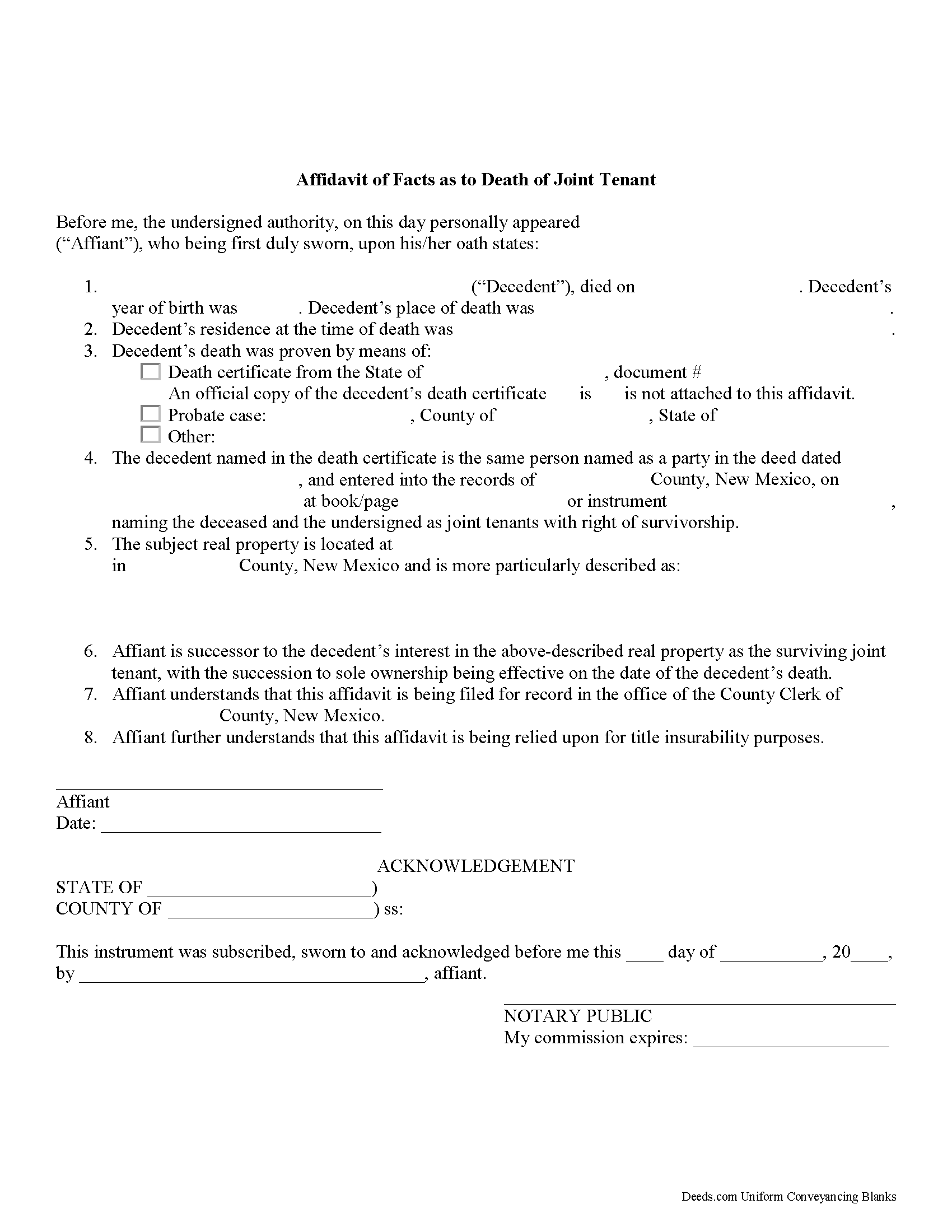
Removing a Deceased Joint Tenant from a New Mexico Real Estate Title
New Mexico's statutes define joint tenancy at 47-1-36. This law states that a "joint tenancy in real property is one owned by two or more persons, each owning the whole and an equal undivided share, by a title created by a single devise or conveyance, when expressly declared . . . to be a joint tenancy." Property titled in this manner cannot be passed in a will; instead, a deceased joint tenant's share is distributed equally amongst the survivors as a function of law until only one person holds the property in sole ownership.
While technically accurate, this description oversimplifies the situation. What happens when it's time to sell the property? Unless the local recording office cross-references death notices with real estate records, the deceased owner's name still appears on the title. This inaccuracy can create confusion during a title search and slow down the transfer process. In addition, outdated ownership information might interfere with property tax billing, which could lead to unnecessary fees and/or penalties.
The surviving owner(s) may prevent these potential issues with a simple step: whe... More Information about the New Mexico Affidavit of Deceased Joint Tenant
Transfer of Homestead Affidavit
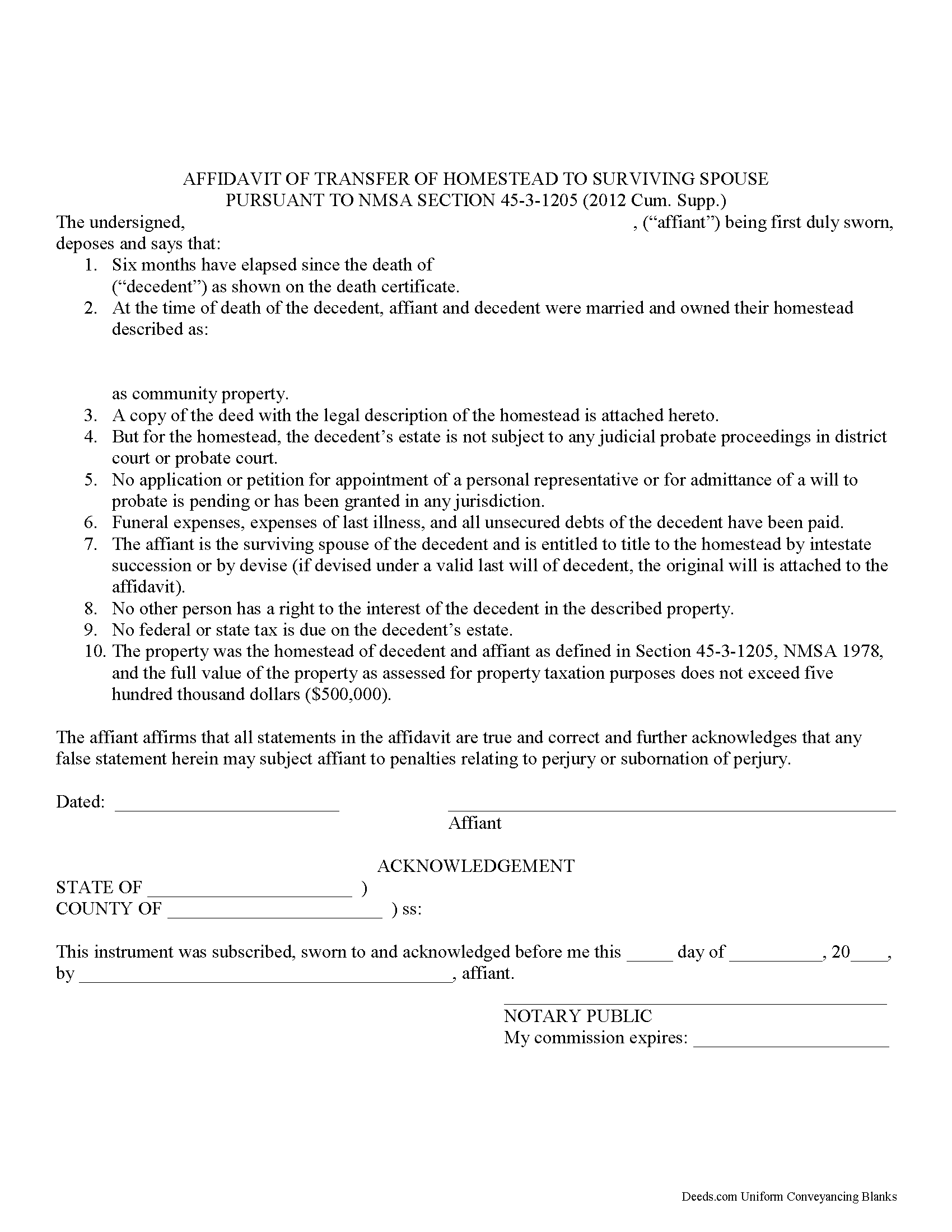
Some married people purchase real estate in New Mexico for vacation or investment purposes and title it as the sole and separate property of one spouse. Others identify themselves as husband and wife, but do not specify how they wish to hold title. In many such situations, the death of one spouse initiates a case with the probate court to distribute the decedent's estate according to his/her will. This judicial proceeding might also include transferring ownership of real estate into the living spouse's name.
But what if the deceased spouse died intestate (without a will) or has arranged for all of his/her assets to pass to named beneficiaries using non-probate options such as joint ownership, transfer on death designations, or trusts? If the house qualifies as a <b>homestead</b> and is vested as <b>community property</b>, the remaining spouse might be able to gain full title rights more easily by using a transfer of homestead affidavit.
This affidavit is designed to transfer the entire shared interest to the surviving spouse without the need for probate. In general, the property must meet six conditions to qualify for a transfer of homestead affidavit under Section 45-3-120... More Information about the New Mexico Transfer of Homestead Affidavit
Mineral Deed
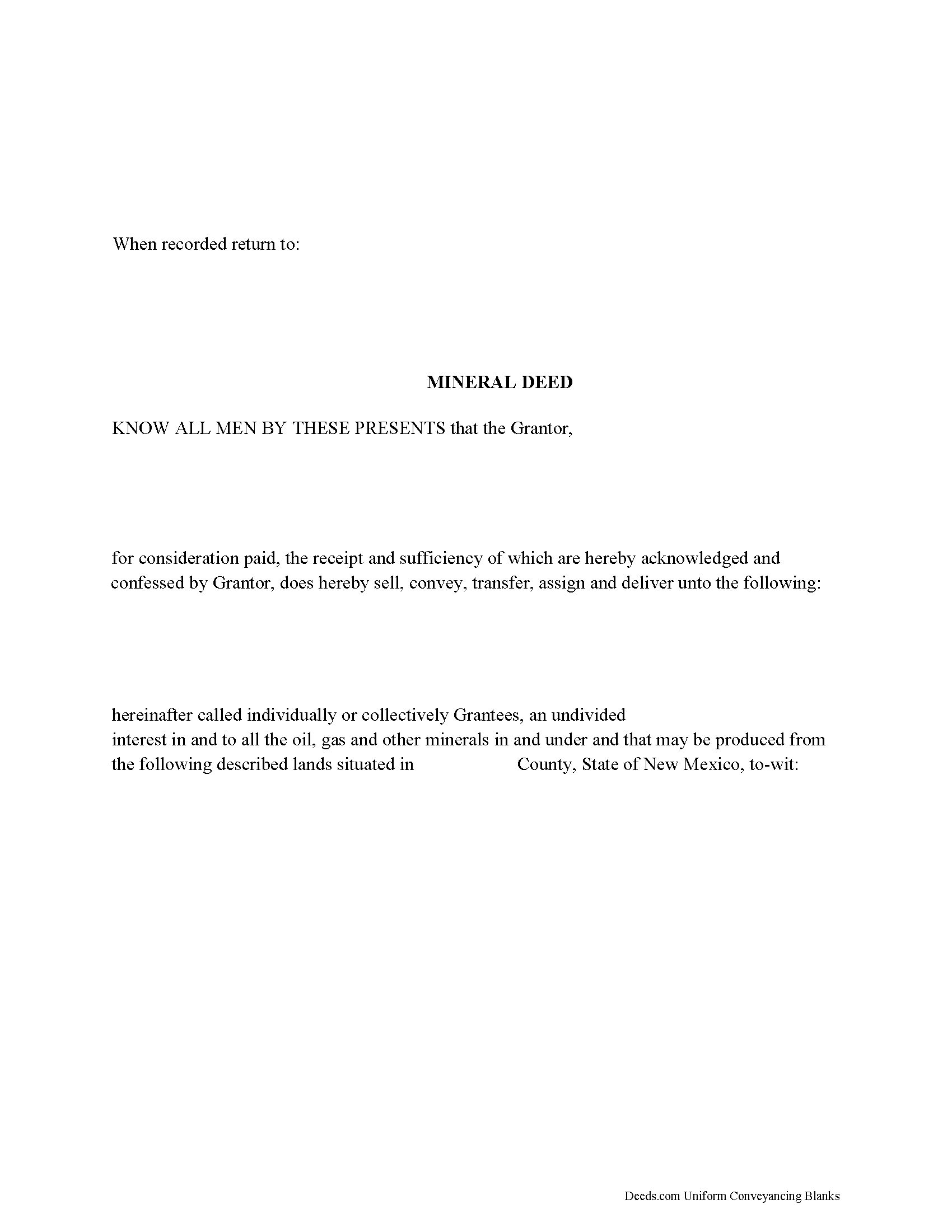
The General Mineral Deed in New Mexico transfers ALL oil, gas, and mineral rights from the grantor to the grantee. THIS IS NOT A LEASE. There are no Exceptions or Reservations included.
The transfer includes all oil, gas, vaporous hydrocarbons, coal, lignite, ores, metals, minerals and mineral products of every kind and nature. It also transfers any and all rights to receive royalties, overriding royalties, net profits interests or other payments out of or with respect to those oil, gas and other minerals.
This general mineral deed gives the grantee the right to extract by wells, mines, shafts, open pits, strip mining or any other method (whether now in use or to be developed in the future), including but not limited to, mining or other methods which are destructive of the surface.
Use of this document has a permanent effect on your rights to the property, if you are not completely sure of what you are executing seek the advice of a legal professional.
(New Mexico MD Package includes form, guidelines, and completed example)... More Information about the New Mexico Mineral Deed
Mineral Deed with Quitclaim Covenants
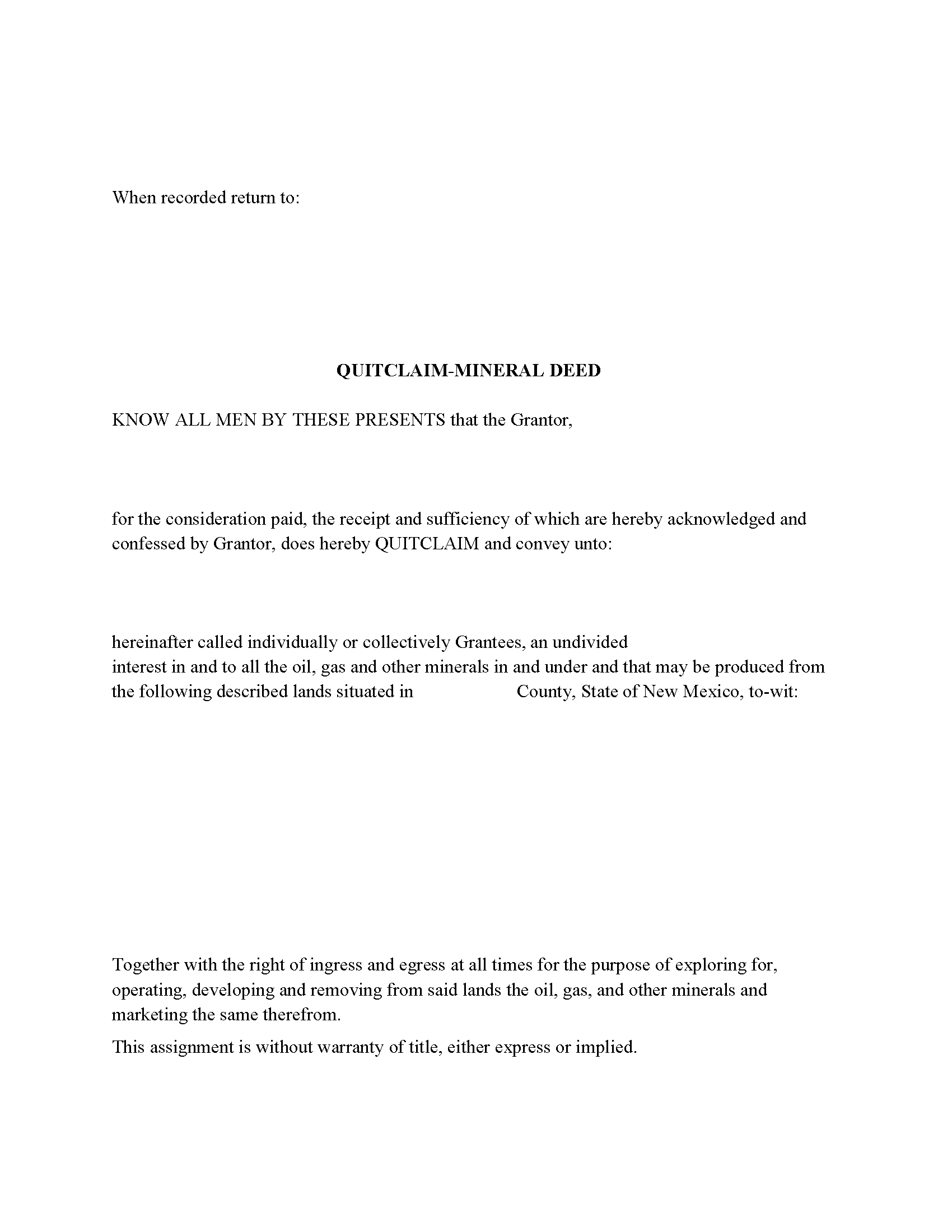
The General Mineral Deed in New Mexico Quitclaims oil, gas, and mineral rights from the grantor to the grantee. THIS IS NOT A LEASE. There are no Exceptions or Reservations included.
The transfer includes the oil, gas and other minerals of every kind and nature. The Grantor can stipulate the percentage of Mineral Rights the Grantee will receive.
This general mineral deed gives the grantee the right to access, for the purpose of mining, drilling, exploring, operating and developing said lands for oil, gas, and other minerals, and storing handling, transporting and marketing of such.
The seller, or grantor Quitclaims the mineral rights and does NOT accept responsibility to any discrepancy of title (This assignment is without warranty of title, either express or implied)
Uses: Mineral deeds with quitclaim are often used in situations where the grantor wants to quickly release any interest they might have in mineral rights, such as in settling estates, resolving disputes, clearing up uncertainties about ownership in a title's history or when mineral rights have previously been severed or fragmented from surface rights and cloud a title, making it difficult to transfer prope... More Information about the New Mexico Mineral Deed with Quitclaim Covenants
Notice of Lis Pendens
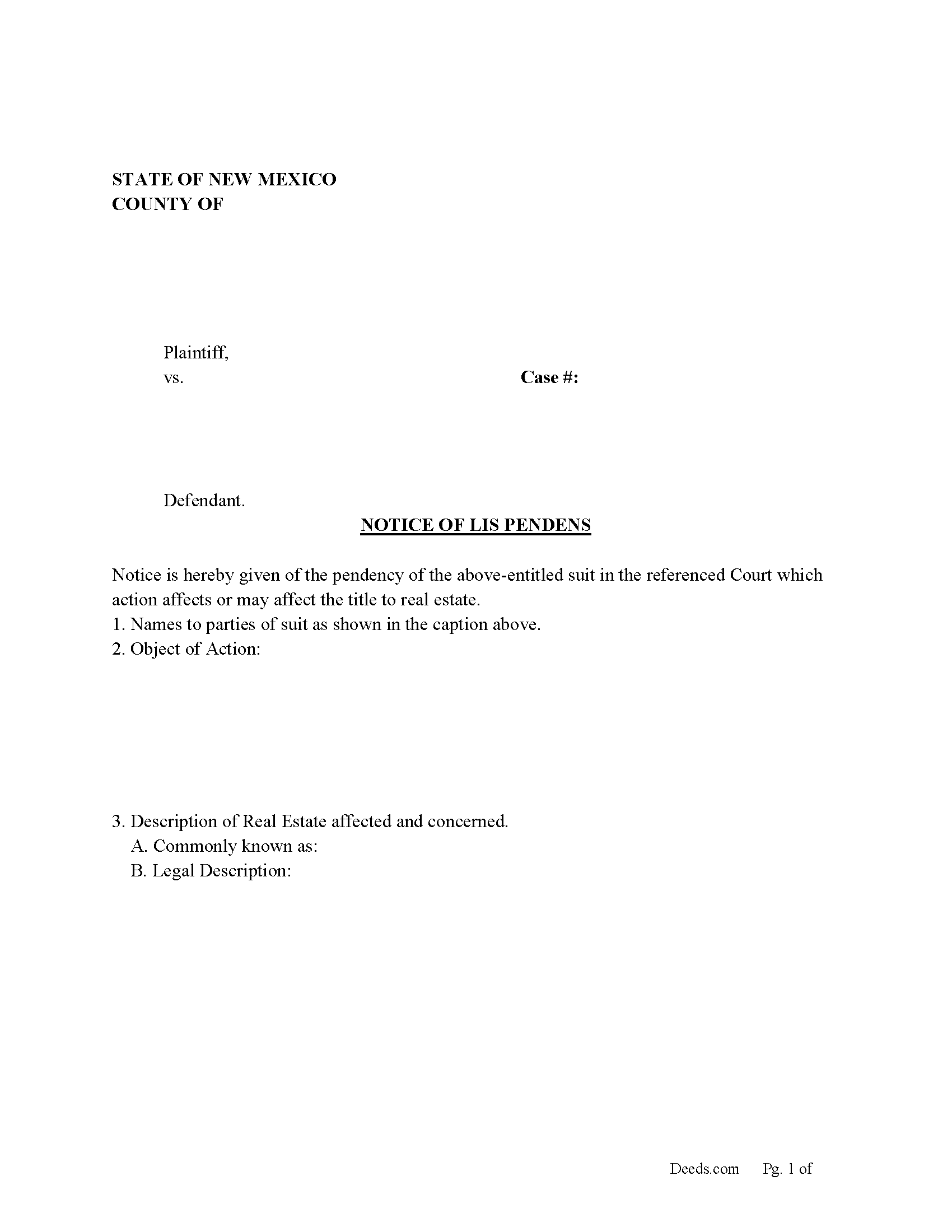
Once filed this Notice of Lis Pendens becomes (constructive notice to a purchaser or encumbrancer of the property concerned; and any person whose conveyance is subsequently recorded shall be considered a subsequent purchaser or encumbrancer and shall be bound by all the proceedings taken after the recording of the notice to the same extent as if he were made a party to the said action.) (NM Statute 38-1-14)
Although a "Lis Pendens" (Latin for "Pending Suit") is not a lien, it acts like a lien in that any would be buyer or Lien-holder takes note that they are subject to the outcome of the pending suit mentioned.
(New Mexico Notice of LP Package includes form, guidelines, and completed example) For use in New Mexico only.
... More Information about the New Mexico Notice of Lis Pendens
Release of Lis Pendens
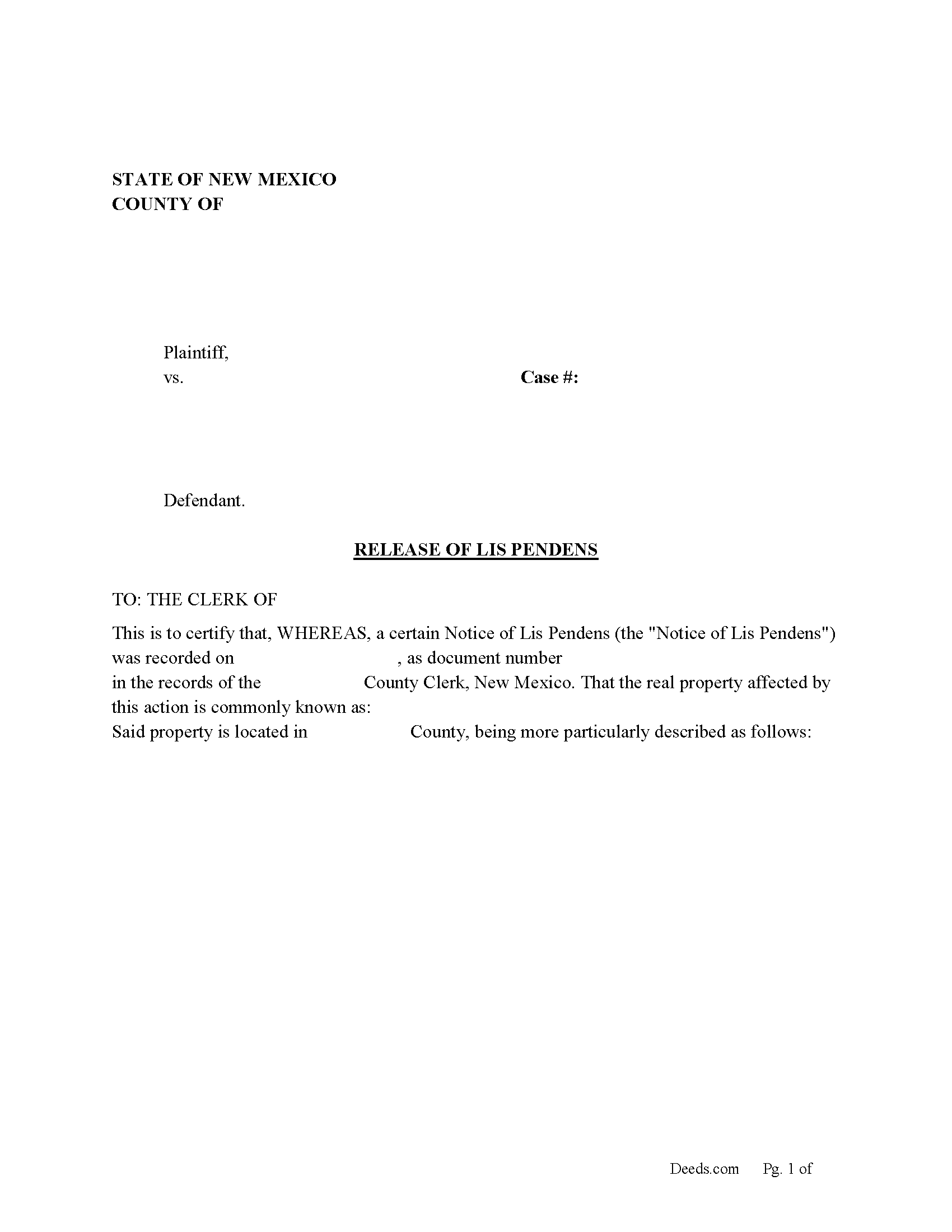
Use this form to cancel a previously recorded Lis Pendens.
(New Mexico Release of LP Package includes form, guidelines, and completed example) For use in New Mexico only.
... More Information about the New Mexico Release of Lis Pendens
Disclaimer of Interest
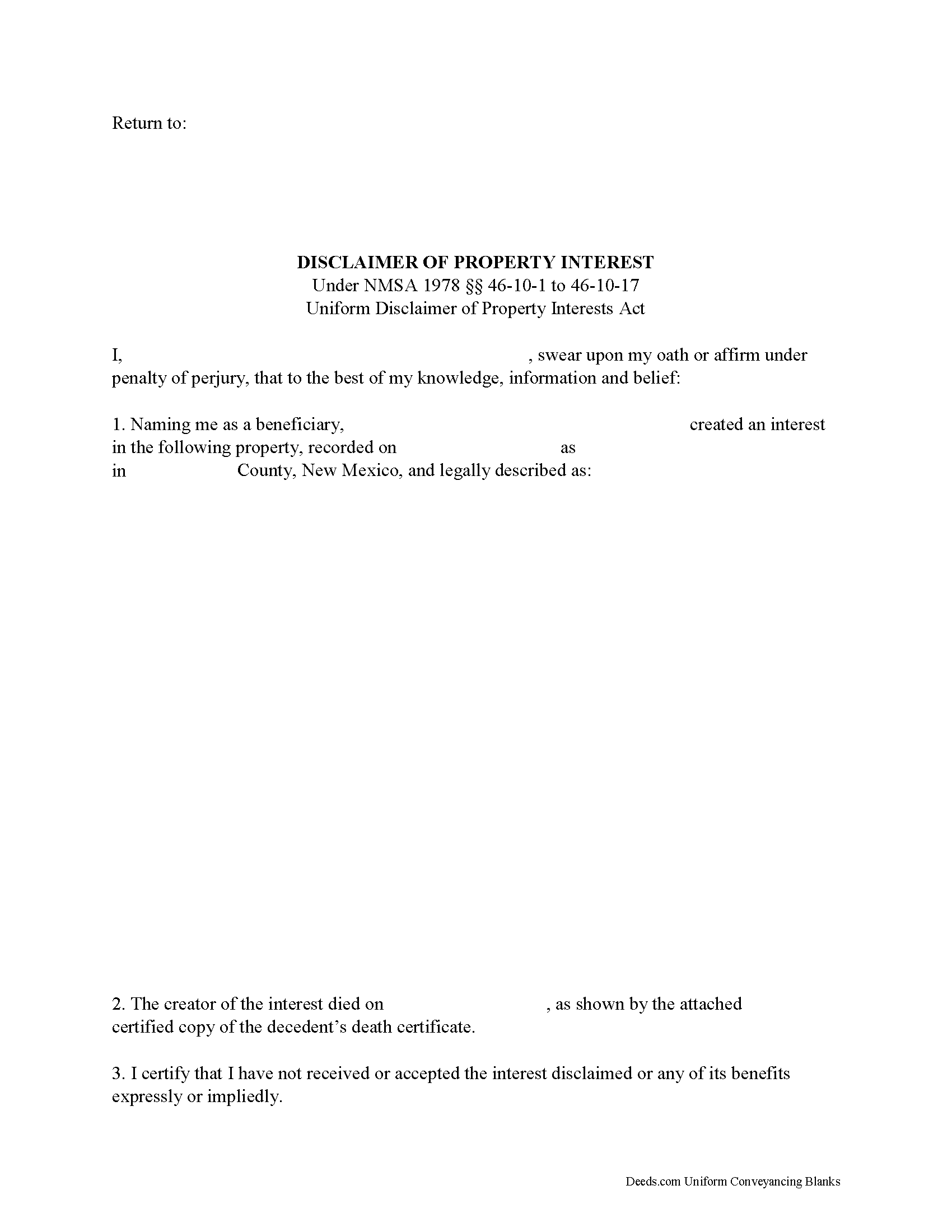
As part of the New Mexico Statutes, the beneficiary of an interest in property may renounce the gift, either in part or in full (Uniform Disclaimer of Property Interests Act NMSA 1978 46-10-1 to 46-10-17). Note that the option to disclaim is only available to beneficiaries who have not acted in any way to indicate acceptance or ownership of the interest ( 46-10-13).
The disclaimer must be in writing and include a description of the interest, a declaration of intent to disclaim all or a defined portion of the interest, and be signed by the disclaimant ( 46-10-5 (c)).
Deliver the disclaimer within nine months of the transfer (e.g., the death of the creator of the interest) to the personal representative of the decedent's estate or the trustee, or file it with the court having authority to appoint such a person or to enforce the trust ( 46-10-12). If real property is involved, record a copy of the disclaimer in the office of the county clerk in the county in which the property or interest disclaimed is located. This helps avoid any ambiguity regarding the chain of title ( 46-10-15).
A disclaimer is irrevocable and binding for the disclaiming party and his or her credito... More Information about the New Mexico Disclaimer of Interest
Certificate of Trust
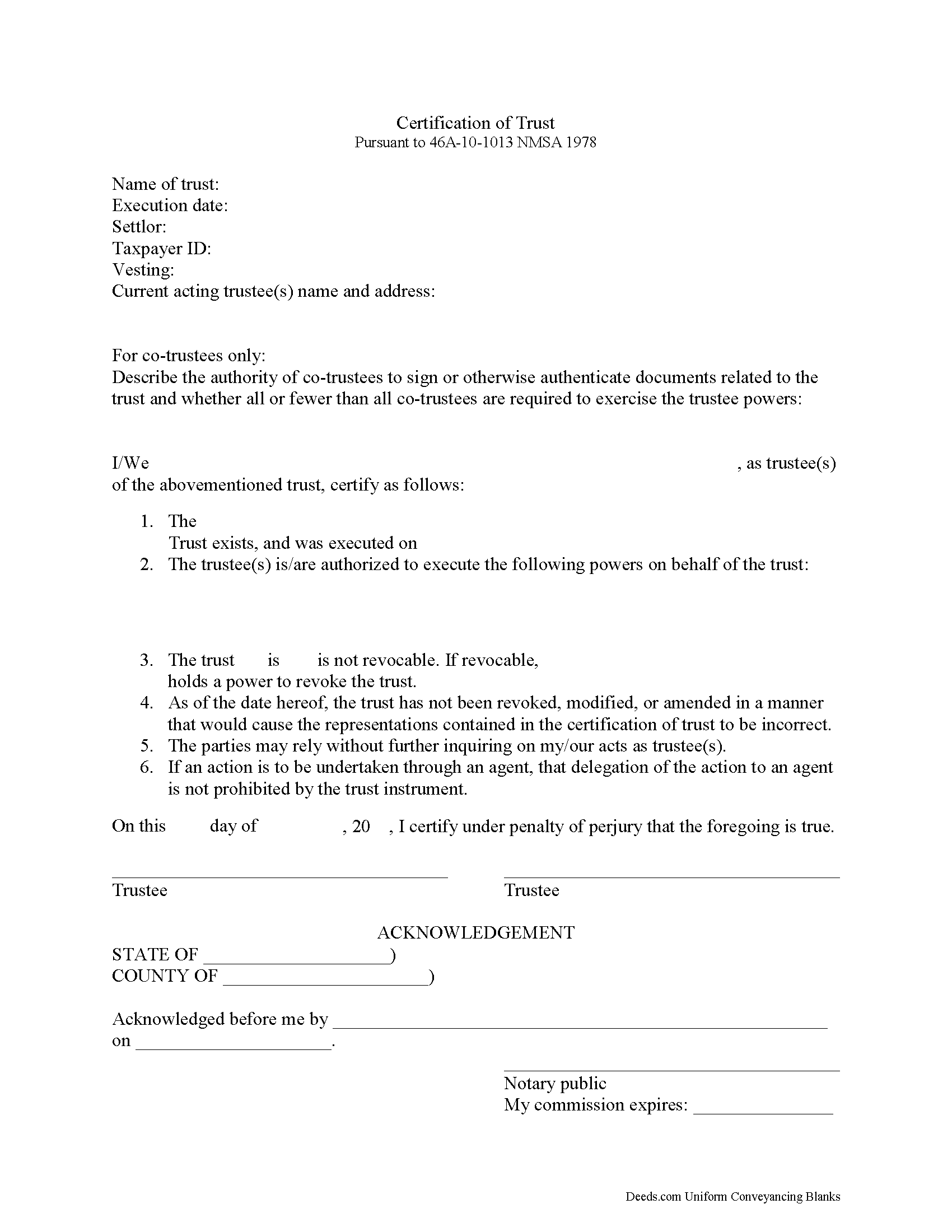
The rules relating to certifications of trust are codified at 46A-10-1013 NMSA 1978. Include this document when conveying an interest in real estate that is held by a trust.
(New Mexico COT Package includes form, guidelines, and completed example)... More Information about the New Mexico Certificate of Trust